图论模板
树基础
知道先序遍历和中序遍历,输出后序遍历
//s1先序遍历,s2中序遍历,输出后序遍历
void work(string s1, string s2)
{
int len = s1.size();
if(len == 1)
{
cout << s1[0];
return;
}
//求根在中序遍历中的位置
int k = s2.find(s1[0]);
string s3, s4;
if(k > 0) //如果位置大于0,表明有左子树
{
s3 = s1.substr(1, k); //左子树的前序遍历
s4 = s2.substr(0, k); //左子树的中序遍历
work(s3, s4);
}
if(k < len - 1) //如果位置小于最后一个字符的下标表明有右子树
{
s3 = s1.substr(k+1, len-k-1); //右子树的前序遍历
s4 = s2.substr(k+1, len-k-1); //右子树的中序遍历
work(s3, s4);
}
cout << s1[0];
}
普通树转二叉树&二叉树的前序、中序、后序遍历
题目:提高组题库【133】普通树转二叉树
#include <bits/stdc++.h>
using namespace std;
const int maxn = 30;
struct node
{
char data;
int lson, rson;
}tr[maxn] = {};
int n = 0;
//前序遍历
void preorder(int rt)
{
printf("%c", tr[rt].data);
if(tr[rt].lson) preorder(tr[rt].lson);
if(tr[rt].rson) preorder(tr[rt].rson);
}
//中序遍历
void inorder(int rt)
{
if(tr[rt].lson) inorder(tr[rt].lson);
printf("%c", tr[rt].data);
if(tr[rt].rson) inorder(tr[rt].rson);
}
//后序遍历
void postorder(int rt)
{
if(tr[rt].lson) postorder(tr[rt].lson);
if(tr[rt].rson) postorder(tr[rt].rson);
printf("%c", tr[rt].data);
}
int main()
{
int x = 0, y = 0;
//
//要将普通树转为二叉树
scanf("%d", &n);
for(int i=1; i<=n; i++)
{
scanf(" %c", &tr[i].data);
//
//第一个叶子节点作为左子树
scanf("%d", &x);
if(x == 0) continue;
tr[i].lson = x;
//
//剩下的叶子节点依次链接为右链
y = x;
while(1)
{
scanf("%d", &x);
if(x == 0) break;
tr[y].rson = x;
y = x;
}
}
//输出前序遍历
preorder(1);
printf("\n");
//输出后序遍历
postorder(1);
return 0;
}
BFS
#include <bits/stdc++.h>
using namespace std;
const int maxn = 10010;
int n = 0, m = 0;
bool g[maxn][maxn] = {};
queue<int> q;
bool vis[maxn] = {};
void bfs(int x)
{
q.push(x);
vis[x] = true;
while(!q.empty())
{
int t = q.front();
printf("%d ", t);
q.pop();
for(int i=1; i<=n; i++)
{
if(g[t][i] && !vis[i])
{
q.push(i);
vis[i] = true;
}
}
}
}
int main()
{
int x = 0, y = 0;
scanf("%d%d", &n, &m);
for(int i=1; i<=m; i++)
{
scanf("%d%d", &x, &y);
g[x][y] = g[y][x] = 1;
}
bfs(1);
return 0;
}
DFS(邻接矩阵)
#include <bits/stdc++.h>
using namespace std;
const int maxn = 110;
int n = 0, m = 0;
int g[maxn][maxn] = {};
bool vis[maxn] = {};
void dfs(int x)
{
vis[x] = true;
printf("%d ", x);
for(int i=1; i<=n; i++)
{
if(!vis[i] && g[x][i])
{
dfs(i);
}
}
}
int main()
{
int x = 0, y = 0;
scanf("%d%d", &n, &m);
for(int i=1; i<=m; i++)
{
scanf("%d%d", &x, &y);
g[x][y] = g[y][x] = 1;
}
dfs(1);
return 0;
}
DFS(邻接链表)
#include <bits/stdc++.h>
using namespace std;
const int maxn = 110;
const int maxm = 10010;
int n = 0, m = 0;
int h[maxn] = {}, tot = 0;
struct edge
{
int to, nxt;
}e[maxm];
int v[maxn] = {};
void addedge(int x, int y)
{
++tot;
e[tot].to = y;
e[tot].nxt = h[x];
h[x] = tot;
}
void dfs(int x)
{
printf("%d ", x);
v[x] = true;
for(int i=h[x]; i; i=e[i].nxt)
{
int y = e[i].to;
if(!v[y])
{
dfs(y);
}
}
}
int main()
{
int x = 0, y = 0;
scanf("%d%d", &n, &m);
for(int i=1; i<=m; i++)
{
scanf("%d%d", &x, &y);
addedge(x, y);
addedge(y, x);
}
dfs(1);
return 0;
}
DFS(vector存边)
#include <bits/stdc++.h>
using namespace std;
const int maxn = 110;
int n = 0, m = 0;
vector<int> e[maxn];
bool v[maxn] = {};
void dfs(int x)
{
v[x] = true;
printf("%d ", x);
for(auto y : e[x])
{
if(!v[y])
{
dfs(y);
}
}
}
int main()
{
int x = 0, y = 0;
scanf("%d%d", &n, &m);
for(int i=1; i<=m; i++)
{
scanf("%d%d", &x, &y);
e[x].push_back(y);
e[y].push_back(x);
}
dfs(1);
return 0;
}
dfs序
dfs序不是唯一的
dfs序一般用于树状结构中,如图:
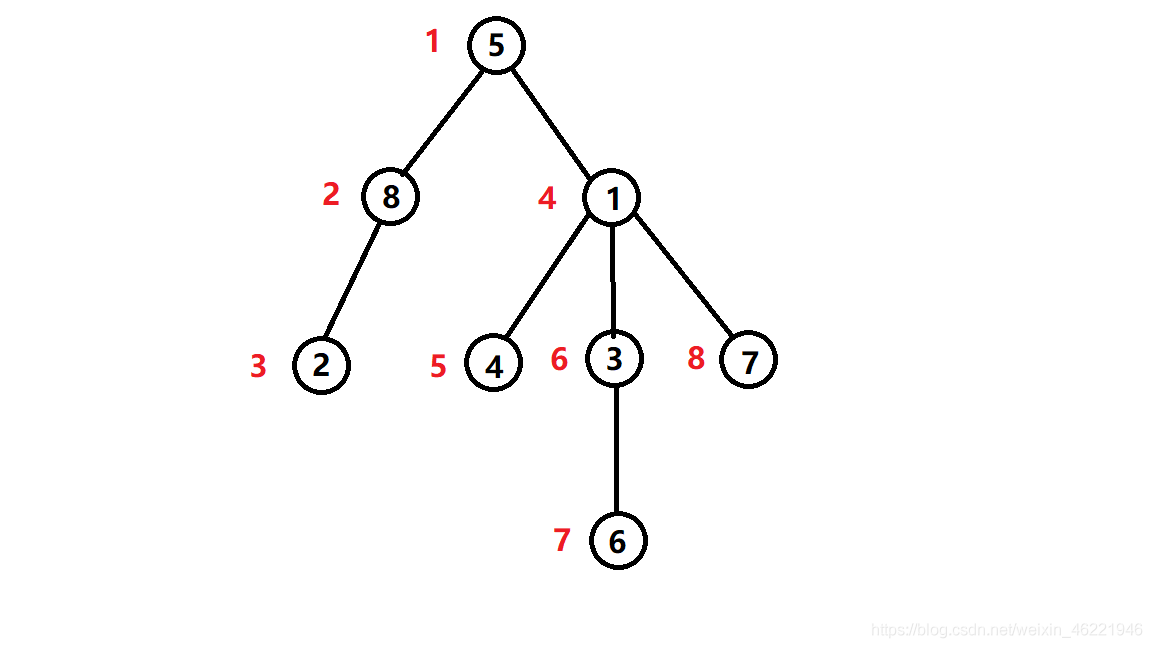
图中红色序号为每个点对应的dfs序序号,黑色序号为每个点默认的序号,我称之为节点序序号(下文同)
可见,dfs序如其名,dfs序序号是按照dfs顺序标记的,所以说给每个节点安排上dfs序序号也很简单,只要dfs的时候顺便标上就行了,dfs第多少次就给dfs到的点标为多少。
void dfs(int x)
{
vis[x] = true;
a[++cnt] = b[x]; //a数组记录的就是dfs序
in[x] = cnt; //记录以x为根节点的子树,在dfs序中开始的下标
int v = 0;
for(int i=head[x]; i; i=nxt[i])
{
v = to[i];
if(vis[v]) continue;
dfs(v);
}
out[x] = cnt;//记录以x为根节点的子树,在dfs序中结束的下标
}
dfs序的主要作用就是将一个子树变成序列上的一个连续区间。
还是以上图为例,
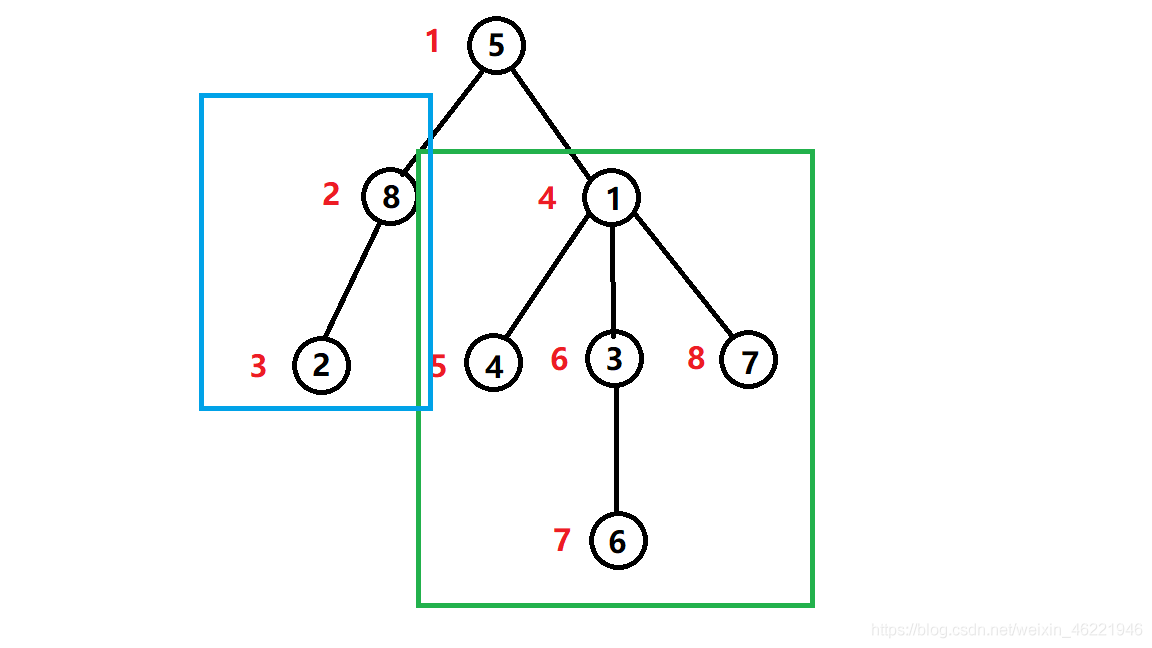
绿色子树可以通过dfs序序号表示出来,4~8;
红色子树表示为2~3;
显然,可以用一连续区间表示出来任意子树。
这样的变换可以解决类似“修改树上某点,输出子树和或者最大值最小值”等问题。
常常配合线段树或树状数组。
欧拉序
欧拉序长得跟dfs序相差无几
储存的则是从根节点开始,按照dfs的顺序经过所有点再绕回原点的路径
共存在两种欧拉序
欧拉序1
这一种欧拉序相当于是在dfs的时候,如果储存节点的栈变化一次,就把栈顶的节点编号记录下来,也就是说,每当访问完一个节点的子树,则需要返回一次该节点,再继续搜索该节点的其余子树,在树上的移动过程为
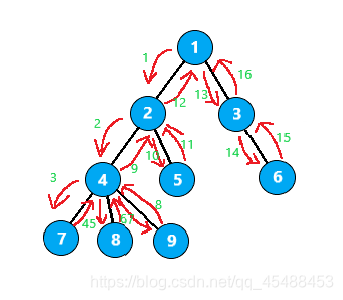
它的搜索顺序便是
1 2 4 7 4 8 4 9 4 2 5 2 1 3 6 3 1
搜索代码:
void euler_dfs1(int p)
{
euler_order1[++pos]=p;
vis[p]=true;
for(int i:G[p])
if(!vis[i])
{
euler_dfs1(i);
euler_order1[++pos]=p; //与dfs序的差别,在搜索完一棵子树后就折返一次自己
}
} //数组需要开2倍n大
欧拉序2
这一种欧拉序相当于是在dfs的时候,如果某个节点入栈,就把这个节点记录下来,直到后面的操作中这个节点出栈,再记录一次这个节点
也就是说,每个节点严格会在记录中出现两次,第一次是搜索到它的时候,第二次是它的子树完全被搜索完的时候
除根节点外,每个节点严格两个入度两个出度
在树上的移动过程为
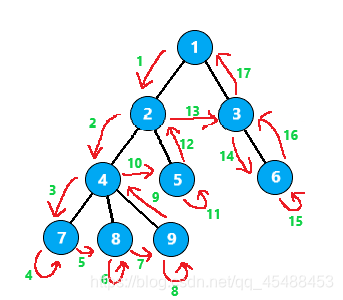
它的搜索顺序便是
1 2 4 7 7 8 8 9 9 4 5 5 2 3 6 6 3 1
可以发现,某个节点在顺序中出现的两次所围成的区间,就表示这个节点与它的子树
欧拉序 2 的搜索代码:
void euler_dfs2(int p)
{
euler_order2[++pos]=p;
vis[p]=true;
for(int i:G[p])
if(!vis[i])
euler_dfs2(i);
euler_order2[++pos]=p; //与dfs序的差别,在所有子树搜索完后再折返自己
} //数组需要开2倍n大
欧拉路&欧拉回路
如果一个图存在一笔画,则一笔画的路径叫做欧拉路,如果最后又回到起点,那这个路径叫做欧拉回路。
我们定义奇点是指跟这个点相连的边数目有奇数个的点。对于能够一笔画的图,我们有以下两个定理。
定理1:存在欧拉路的充要条件:图是连通的,有且只有2个奇点。
定理2:存在欧拉回路的充要条件:图是连通的,有0个奇点。
两个定理的正确性是显而易见的,既然每条边都要经过一次,那么对于欧拉路,除了起点和终点外,每个点如果进入了一次,显然一定要出去一次,显然是偶点。对于欧拉回路,每个点进入和出去次数一定都是相等的,显然没有奇点。
求欧拉路的算法:寻找节点的度为奇数的点,作为欧拉路的起点,执行深度优先遍历即可。
求欧拉回路的算法:以任意一个点为起点,执行深度优先遍历即可
例题:提高组题库,骑马修栅栏
#include <bits/stdc++.h>
using namespace std;
const int maxn = 510;
int n = 0, m = 0; //n表示点数
int g[maxn][maxn] = {};
int du[maxn] = {};
void dfs(int x)
{
printf("%d\n", x);
//保证先搜顶点号小的,再搜顶点号大的
for(int i=1; i<=n; i++)
{
if(g[x][i])
{
g[x][i]--;
g[i][x]--;
dfs(i);
}
}
}
int main()
{
int x = 0, y = 0;
scanf("%d", &m);
for(int i=1; i<=m; i++)
{
scanf("%d%d", &x, &y);
g[x][y]++;
g[y][x]++;
du[x]++;
du[y]++;
if(n < x) n = x;
if(n < y) n = y;
}
//寻找节点的度为奇数的点,作为欧拉路的起点
//没有度为奇数的点,则从1开始,求欧拉回路
int st = 1;
for(int i=1; i<=n; i++)
{
if(du[i] % 2 == 1)
{
st = i;
break;
}
}
dfs(st);
return 0;
}
最短路
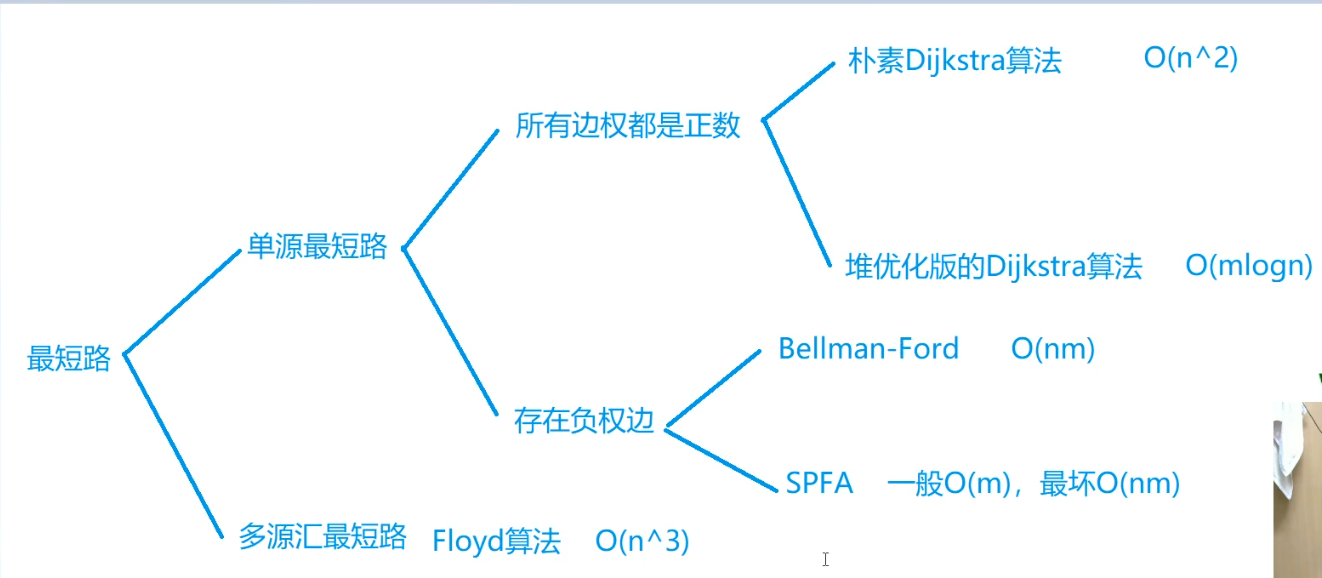
Floyed
时间复杂度是\(O(n^3)\),n表示点数。
//初始化
memset(dis, 0x3f, sizeof(dis));
for(int i=1; i<=n; i++) dis[i][i] = 0;
//算法结束后,dis[x][y]表示x到y的最短距离
void floyd()
{
for(int k=1; i<=n; k++)
{
for(int i=1; i<=n; i++)
{
for(int j=1; j<=n; j++)
{
dis[i][j] = min(dis[i][j], dis[i][k] + dis[k][j]);
}
}
}
}
Dijkstra
朴素的Dijkstra & 邻接矩阵存图
时间复杂度是\(O(n^2+m)\),n表示点数,m表示边数
例题:提高组题库,148信使
//初始化
#include <bits/stdc++.h>
using namespace std;
const int maxn = 510;
const int inf = 0x7f7f7f7f;
int n = 0, m = 0;
int g[maxn][maxn] = {}; //朴素版的dijkstra算法多用与稠密图,因此用邻接矩阵存图
int dis[maxn] = {}; //存储1号点到每个点的最短距离
int vis[maxn] = {}; //存储每个点的最短路是否已经确定
void dij()
{
memset(dis, 0x3f, sizeof(dis));
dis[1] = 0;
for(int i=1; i<n; i++)
{
int t = -1;
//在还未确定最短路的点中,寻找距离最小的点
for(int j=1; j<=n; j++)
{
if(!vis[j] && (t==-1 || dis[t]>dis[j])) t = j;
}
//用t更新其他点的距离
for(int j=1; j<=n; j++)
{
dis[j] = min(dis[j], dis[t] + g[t][j]);
}
vis[t] = true;
}
}
int main()
{
int x = 0, y = 0, z = 0;
scanf("%d%d", &n, &m);
memset(g, 0x3f, sizeof(g));
for(int i=1; i<=n; i++) g[i][i] = 0;
for(int i=1; i<=m; i++)
{
scanf("%d%d%d", &x, &y, &z);
g[x][y] = g[y][x] = z;
}
dij();
int ans = 0;
for(int i=1; i<=n; i++)
{
if(dis[i] == 0x3f3f3f3f)
{
printf("-1");
return 0;
}
if(ans < dis[i]) ans = dis[i];
}
printf("%d", ans);
return 0;
}
朴素的Dijkstra & 链式前向星存图
例题:提高组题库,148信使
#include <bits/stdc++.h>
using namespace std;
const int maxn = 110;
const int maxm = 10010;
int n = 0, m = 0;
int h[maxn] = {}, to[maxm] ={}, nxt[maxm] = {}, w[maxm] = {}, tot = 0;
int dis[maxn] = {}, vis[maxn] = {};
void addedge(int x, int y, int z)
{
to[++tot] = y;
w[tot] = z;
nxt[tot] = h[x];
h[x] = tot;
}
void dij()
{
memset(dis, 0x3f, sizeof(dis));
dis[1] = 0;
for(int i=1; i<=n; i++)
{
int t = -1;
for(int j=1; j<=n; j++)
{
if(!vis[j] && (t == -1 || dis[t] > dis[j])) t = j;
}
for(int i=h[t]; i; i=nxt[i])
{
int y = to[i];
dis[y] = min(dis[y], dis[t] + w[i]);
}
vis[t] = true;
}
}
int main()
{
int x = 0, y = 0, z = 0;
scanf("%d%d", &n, &m);
for(int i=1; i<=m; i++)
{
scanf("%d%d%d", &x, &y, &z);
addedge(x, y, z);
addedge(y, x, z);
}
dij();
int ans = 0;
for(int i=1; i<=n; i++)
{
ans = max(ans, dis[i]);
}
if(ans == 0x3f3f3f3f) printf("-1\n");
else printf("%d\n", ans);
return 0;
}
堆优化Dijkstra & 链式前向星存图
时间复杂度是\(O(mlog(n))\),n表示点数,m表示边数
例题:提高组题库,148信使
#include <bits/stdc++.h>
using namespace std;
const int maxn = 110;
const int maxm = maxn * maxn;
const int inf = 0x7f7f7f7f;
int n = 0, m = 0;
int h[maxn] = {}, to[maxm] = {}, nxt[maxm] = {}, w[maxm] = {}, tot = 0;
int dis[maxn] = {};
bool vis[maxn] = {};
priority_queue<pair<int, int>> q;
void addedge(int x, int y, int z)
{
to[++tot] = y;
nxt[tot] = h[x];
w[tot] = z;
h[x] = tot;
}
void dij(int x)
{
memset(dis, 0x3f, sizeof(dis));
dis[x] = 0;
q.push(make_pair(0, x));
while(q.size())
{
x = q.top().second;
q.pop();
if(vis[x]) continue;
vis[x] = true;
for(int i=h[x]; i; i=nxt[i])
{
int y = to[i];
if(dis[y] > dis[x] + w[i])
{
dis[y] = dis[x] + w[i];
q.push(make_pair(-dis[y], y));
}
}
}
}
int main()
{
int x = 0, y = 0, z = 0;
scanf("%d%d", &n, &m);
for(int i=1; i<=m; i++)
{
scanf("%d%d%d", &x, &y, &z);
addedge(x, y, z);
addedge(y, x, z);
}
dij(1);
int ans = 0;
for(int i=1; i<=n; i++)
{
if(dis[i] == 0x3f3f3f3f)
{
printf("-1");
return 0;
}
if(ans < dis[i]) ans = dis[i];
}
printf("%d", ans);
return 0;
}
Bellman-Ford算法
在最短路存在的情况下,由于一次松弛操作会使最短路的边数至少+1,而最短路的边数最多为n-1,
因此整个算法最多执行n-1轮松弛操作。
故时间复杂度为O(nm)
判断负环:
如果图中有负环,松弛操作会无休止的进行下去。
因此,我们循环n次,n轮循环时,仍然存在能松弛的边,说明存在负环
时间复杂度是\(O(nm)\),n表示点数,m表示边数
可以用该算法求最长路
例题:提高组题库,148信使
#include <bits/stdc++.h>
using namespace std;
/*
在最短路存在的情况下,由于一次松弛操作会使最短路的边数至少+1,而最短路的边数最多为n-1,
因此整个算法最多执行n-1轮松弛操作。
故时间复杂度为O(nm)
判断负环:
如果图中有负环,松弛操作会无休止的进行下去。
因此,我们循环n次,n轮循环时,仍然存在能松弛的边,说明存在负环
*/
const int maxn = 110;
const int maxm = maxn * maxn;
const int inf = 0x3f3f3f3f;
int n = 0, m = 0;
int dis[maxn] = {};
struct edge
{
int x, y, w;
}e[maxm];
bool bellman_ford()
{
memset(dis, 0x3f, sizeof(dis));
dis[1] = 0;
bool flag = false; //判断一轮循环过程中是否发生松弛操作
for(int i=1; i<=n; i++)
{
flag = false;
for(int j=1; j<=m*2; j++)
{
int x = e[j].x, y = e[j].y, w = e[j].w;
//无穷大与常数加减仍然为无穷大
//因此最短路长度为inf的点引出的边不可能发生松弛操作
if(dis[x] == inf) continue;
if(dis[y] > dis[x] + w)
{
dis[y] = dis[x] + w;
flag = true;
}
}
//没有可以松弛的边时就停止算法
if(!flag) break;
}
//第n轮循环仍然可以松弛时说明存在负环
return flag;
}
int main()
{
int x = 0, y = 0, z = 0;
scanf("%d%d", &n, &m);
for(int i=1; i<=m; i++)
{
scanf("%d%d%d", &x, &y, &z);
//无向图,边需要加两次
e[i].x = x;
e[i].y = y;
e[i].w = z;
e[m+i].x = y;
e[m+i].y = x;
e[m+i].w = z;
}
bellman_ford();
int ans = 0;
for(int i=1; i<=n; i++)
{
if(dis[i] == 0x3f3f3f3f)
{
printf("-1");
return 0;
}
if(ans < dis[i]) ans = dis[i];
}
printf("%d", ans);
return 0;
}
spfa算法
也叫做 队列优化的Bellman-Ford算法
时间复杂度:平均情况下是\(O(m)\),最坏情况下\(O(nm)\),n表示点数,m表示边数
例题:提高组题库,148信使
#include <bits/stdc++.h>
using namespace std;
const int maxn = 110;
const int maxm = maxn * maxn;
const int inf = 0x7f7f7f7f;
int n = 0, m = 0;
int h[maxn] = {}, to[maxm] = {}, nxt[maxm] = {}, w[maxm] = {}, tot = 0;
int dis[maxn] = {};
bool vis[maxn] = {};
queue<int> q;
void addedge(int x, int y, int z)
{
to[++tot] = y;
nxt[tot] = h[x];
w[tot] = z;
h[x] = tot;
}
void spfa(int x)
{
memset(dis, 0x3f, sizeof(dis));
dis[x] = 0;
q.push(x);
while(q.size())
{
x = q.front();
q.pop();
vis[x] = false;
for(int i=h[x]; i; i=nxt[i])
{
int y = to[i];
if(dis[y] > dis[x] + w[i])
{
dis[y] = dis[x] + w[i];
if(!vis[y]) q.push(y);
}
}
}
}
int main()
{
int x = 0, y = 0, z = 0;
scanf("%d%d", &n, &m);
for(int i=1; i<=m; i++)
{
scanf("%d%d%d", &x, &y, &z);
addedge(x, y, z);
addedge(y, x, z);
}
spfa(1);
int ans = 0;
for(int i=1; i<=n; i++)
{
if(dis[i] == 0x3f3f3f3f)
{
printf("-1");
return 0;
}
if(ans < dis[i]) ans = dis[i];
}
printf("%d", ans);
return 0;
}
判断负环
bfs写法
使用spfa算法判断负环,有两种方法
方法 1:统计每个点入队的次数,如果某个点入队大于等于n次,则说明存在负环
方法 2:统计当前每个点的最短路中所包含的边数,如果某点的最短路所包含的边数大于等于n,则也说明存在负环
例题:提高题库 158.Wormholes 虫洞
判断点入队次数(方法1)
#include <bits/stdc++.h>
using namespace std;
const int maxn = 510;
const int maxm = 6000;
const int inf = 0x3f3f3f3f;
int n = 0, m = 0, s = 0;
int h[maxn] = {}, to[maxm] = {}, nxt[maxm] = {}, w[maxm] = {}, tot = 0;
int dis[maxn] = {};
bool vis[maxn] = {};
//记录某个节点入队次数
int cnt[maxn] = {};
void addedge(int x, int y, int z)
{
to[++tot] = y;
nxt[tot] = h[x];
w[tot] = z;
h[x] = tot;
}
bool spfa()
{
memset(vis, 0, sizeof(vis));
queue<int> q;
for(int i=1; i<=n; i++)
{
q.push(i);
vis[i] = true;
}
while(q.size())
{
int x = q.front();
q.pop();
vis[x] = false;
for(int i=h[x]; i; i=nxt[i])
{
int y = to[i];
if(dis[y] > dis[x] + w[i])
{
dis[y] = dis[x] + w[i];
if(!vis[y])
{
q.push(y);
vis[y] = true;
//如果某个节点入队次数>=n次,表示有负环
cnt[y]++;
if(cnt[y] >= n) return true;
}
}
}
}
return false;
}
int main()
{
int T = 0;
scanf("%d", &T);
while(T--)
{
tot = 0;
memset(h, 0, sizeof(h));
memset(to, 0, sizeof(to));
memset(nxt, 0, sizeof(nxt));
memset(w, 0, sizeof(w));
memset(cnt, 0, sizeof(cnt));
int x = 0, y = 0, z = 0;
scanf("%d%d%d", &n, &m, &s);
for(int i=1; i<=m; i++)
{
scanf("%d%d%d", &x, &y, &z);
addedge(x, y, z);
addedge(y, x, z);
}
for(int i=1; i<=s; i++)
{
scanf("%d%d%d", &x, &y, &z);
addedge(x, y, -z);
}
if(spfa()) printf("YES\n");
else printf("NO\n");
}
return 0;
}
判断边数(方法2)
#include <bits/stdc++.h>
using namespace std;
const int maxn = 510;
const int maxm = 6000;
const int inf = 0x3f3f3f3f;
int n = 0, m = 0, s = 0;
int h[maxn] = {}, to[maxm] = {}, nxt[maxm] = {}, w[maxm] = {}, tot = 0;
int dis[maxn] = {};
bool vis[maxn] = {};
//记录某条路径上边的数量
int cnt[maxn] = {};
void addedge(int x, int y, int z)
{
to[++tot] = y;
nxt[tot] = h[x];
w[tot] = z;
h[x] = tot;
}
bool spfa()
{
memset(vis, 0, sizeof(vis));
queue<int> q;
for(int i=1; i<=n; i++)
{
q.push(i);
vis[i] = true;
}
while(q.size())
{
int x = q.front();
q.pop();
vis[x] = false;
for(int i=h[x]; i; i=nxt[i])
{
int y = to[i];
if(dis[y] > dis[x] + w[i])
{
dis[y] = dis[x] + w[i];
//如果某条路径边的数量>=n,表示有负环
cnt[y] = cnt[x] + 1;
if(cnt[y] >= n) return true;
if(!vis[y])
{
q.push(y);
vis[y] = true;
}
}
}
}
return false;
}
int main()
{
int T = 0;
scanf("%d", &T);
while(T--)
{
tot = 0;
memset(h, 0, sizeof(h));
memset(to, 0, sizeof(to));
memset(nxt, 0, sizeof(nxt));
memset(w, 0, sizeof(w));
memset(cnt, 0, sizeof(cnt));
int x = 0, y = 0, z = 0;
scanf("%d%d%d", &n, &m, &s);
for(int i=1; i<=m; i++)
{
scanf("%d%d%d", &x, &y, &z);
addedge(x, y, z);
addedge(y, x, z);
}
for(int i=1; i<=s; i++)
{
scanf("%d%d%d", &x, &y, &z);
addedge(x, y, -z);
}
if(spfa()) printf("YES\n");
else printf("NO\n");
}
return 0;
}
dfs写法
memset(dis, 0x3f, sizeof(dis));
dis[0] = 0;//起始点为0点
void spfa(int x)
{
vis[x] = true;//标记是否在dfs中
for(int i=h[x]; i; i=nxt[i])
{
int y = to[i];
if(dis[y] > dis[x] + w[i])
{
if(vis[y])//如果在dfs中,说明有负环
{
printf("No");
exit(0);
}
dis[y] = dis[x] + w[i];
spfa(y);
}
}
vis[x] = false;
}
二维最短路
例题:提高题库 157.传送门
#include <bits/stdc++.h>
using namespace std;
const int maxn = 10010;
const int maxm = 100010;
const int inf = 0x3f3f3f3f;
int n = 0, m = 0, k = 0;
int h[maxn] = {}, to[maxm] = {}, nxt[maxm] = {}, w[maxm] = {}, tot = 0;
int dis[maxn][25] = {};
bool vis[maxn][25] = {};
struct node
{
int x, t, dis;
node(){}
node(int a, int b, int c)
{
x = a;
t = b;
dis = c;
}
bool operator < (const node &nd) const
{
if(dis == nd.dis) return t > nd.t;
return dis > nd.dis;
}
};
priority_queue<node> q;
void addedge(int x, int y, int z)
{
to[++tot] = y;
nxt[tot] = h[x];
w[tot] = z;
h[x] = tot;
}
//优先队列优化的二维spfa
void dij(int x)
{
memset(dis, 0x3f, sizeof(dis));
dis[x][0] = 0;
q.push(node(x, 0, 0));
vis[x][0] = true;
while(q.size())
{
x = q.top().x;
int t = q.top().t;
q.pop();
vis[x][t] = true;
for(int i=h[x]; i; i=nxt[i])
{
int y = to[i];
//不用传送门
if(!vis[y][t] && dis[y][t] > dis[x][t] + w[i])
{
dis[y][t] = dis[x][t] + w[i];
if(!vis[y][t]) q.push(node(y, t, dis[y][t]));
}
//用传送门
if(t < k)
{
if(!vis[y][t+1] && dis[y][t+1] > dis[x][t])
{
dis[y][t+1] = dis[x][t];
if(!vis[y][t+1]) q.push(node(y, t+1, dis[y][t+1]));
}
}
}
}
}
int main()
{
int x = 0, y = 0, z = 0;
scanf("%d%d%d", &n, &m, &k);
for(int i=1; i<=m; i++)
{
scanf("%d%d%d", &x, &y, &z);
addedge(x, y, z);
addedge(y, x, z);
}
dij(1);
int ans = 0x7fffffff;
for(int i=0; i<=k; i++)
{
ans = min(ans, dis[n][k]);
}
printf("%d", ans);
return 0;
}
最小生成树

朴素版prim算法
时间复杂度\(O(n^2)\),可以用二叉堆优化到\(O(mlogn)\)。
但用二叉堆优化不如直接用Kruskal算法更加方便。因此,Prim主要用于稠密图,尤其是完全图的最小生成树的求解
例题:提高题库 175.最优布线问题
#include <bits/stdc++.h>
using namespace std;
const int maxn = 110;
int n = 0; //n表示点数
//g[][]邻接矩阵存图,d[]存储其他点到当前最小生成树的距离
int g[maxn][maxn] = {}, d[maxn] = {}, ans = 0;
bool vis[maxn] = {}; //存储每个点是否已经在生成树中
void prim()
{
memset(d, 0x3f, sizeof(d));
memset(vis, 0, sizeof(vis));
d[1] = 0;
for(int i=1; i<n; i++)
{
//找到距离已确定点集合距离最短的点x
int x = 0;
for(int j=1; j<=n; j++)
{
if(!vis[j] && (x==0 || d[x]>d[j])) x = j;
}
vis[x] = true;
//更新x点到与其相连的点的距离,即更新其他点到已确定点集合的距离
for(int j=1; j<=n; j++)
{
if(!vis[j]) d[j] = min(d[j], g[x][j]);
}
}
}
int main()
{
scanf("%d", &n);
for(int i=1; i<=n; i++)
{
for(int j=1; j<=n; j++)
{
scanf("%d", &g[i][j]);
}
}
prim();
for(int i=1; i<=n; i++) ans += d[i];
printf("%d", ans);
return 0;
}
堆优化prim算法
写法复杂,基本用不到
Kruskal
时间复杂度\(O(mlogm)\)
例题:提高题库 176.局域网
#include <bits/stdc++.h>
using namespace std;
const int maxn = 110;
const int maxm = maxn * maxn;
int n = 0, m = 0; //n表示点数,m表示边数
int fa[maxn] = {}, ans = 0, sum = 0;
struct node
{
int x, y, z;
bool operator < (const node &nd) const
{
return z < nd.z;
}
}e[maxm];
int findset(int x)
{
if(fa[x] != x) fa[x] = findset(fa[x]);
return fa[x];
}
void Kruskal()
{
int t = 0;
//按边权从小到大排序
sort(e+1, e+1+m);
//并查集初始化
for(int i=1; i<=n; i++) fa[i] = i;
//求最小生成树
for(int i=1; i<=m; i++)
{
int fx = findset(e[i].x);
int fy = findset(e[i].y);
if(fx == fy) continue;
fa[fy] = fx;
ans += e[i].z;
t++;
if(t == n-1) break;
}
}
int main()
{
scanf("%d%d", &n, &m);
for(int i=1; i<=m; i++)
{
scanf("%d%d%d", &e[i].x, &e[i].y, &e[i].z);
sum += e[i].z;
}
Kruskal();
printf("%d", sum - ans);
return 0;
}
拓扑排序
定义: 在一个\(DAG\)(有向无环图)中,将图中的顶点以线性方式进行排序,使得对于任何的顶点\(u\)到\(v\)的有向边\((u,v)\),都可以有\(u\)在\(v\)的前面。
目标: 将所有节点排序,使得排在前面的节点不能依赖于排在后面的节点。
时间复杂度: \(O(n+m)\),n表示点数,m表示边数
样例:
给定一个\(DAG\),求出其拓扑排序
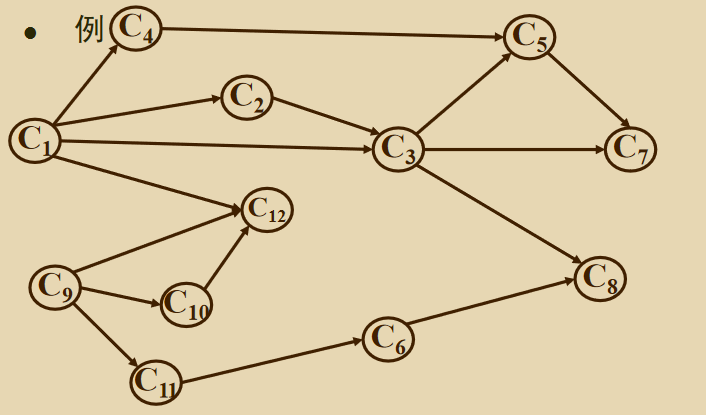
上图的拓扑序列可能是下面两种:
(C1, C2, C3, C4, C5, C7, C9, C10, C11, C6, C12, C8)
(C9, C10, C11, C6, C1, C12, C4, C2, C3, C5, C7, C8)
注意: 一个\(DAG\)的拓扑序列不唯一,与存图顺序有关,只要满足拓扑排序的定义即可
拓扑排序与\(bfs\):
1、\(bfs\)可用于有向图或无向图,有环或无环
2、拓扑排序只能把入度为\(0\)的点作为起点,\(bfs\)可以把任意点作为起点
3、因此拓扑排序可以认为是一种特殊的\(bfs\)
int in[maxn] = {}; //存储某个节点的入度
bool topsort()
{
int cnt = 0; //记录经过的节点数量
queue<int> q;
//将入度为0的节点入队
for(int i=1; i<=n; i++)
{
if(in[i] == 0) q.push(i);
}
while(!q.empty())
{
int x = q.front();
q.pop();
cnt++;
for(int i=h[x]; i; i=nxt[i])
{
int y = to[i];
in[y]--;
if(in[y] == 0) q.push(y);
}
}
if(cnt == n) return true;
return false;
}
例题:P262 家谱树
#include <bits/stdc++.h>
using namespace std;
const int maxn = 110;
const int maxm = maxn*maxn;
int n = 0;
int head[maxn] = {}, to[maxm] = {}, nxt[maxm] = {}, tot = 0;
queue<int> q;
int v[maxn] = {};
int in[maxn] = {};
void addedge(int x, int y)
{
nxt[++tot] = head[x];
to[tot] = y;
head[x] = tot;
}
void tpsort()
{
for(int i=1; i<=n; i++)
{
if(in[i] == 0) q.push(i);
}
while(q.size())
{
int x = q.front();
q.pop();
printf("%d ", x);
for(int i=head[x]; i; i=nxt[i])
{
int y = to[i];
in[y]--;
if(in[y] == 0) q.push(y);
}
}
}
int main()
{
int x = 0;
scanf("%d", &n);
for(int i=1; i<=n; i++)
{
while(1)
{
scanf("%d", &x);
if(x == 0) break;
addedge(i, x);
in[x]++;
}
}
tpsort();
return 0;
}
二分图

差分约束
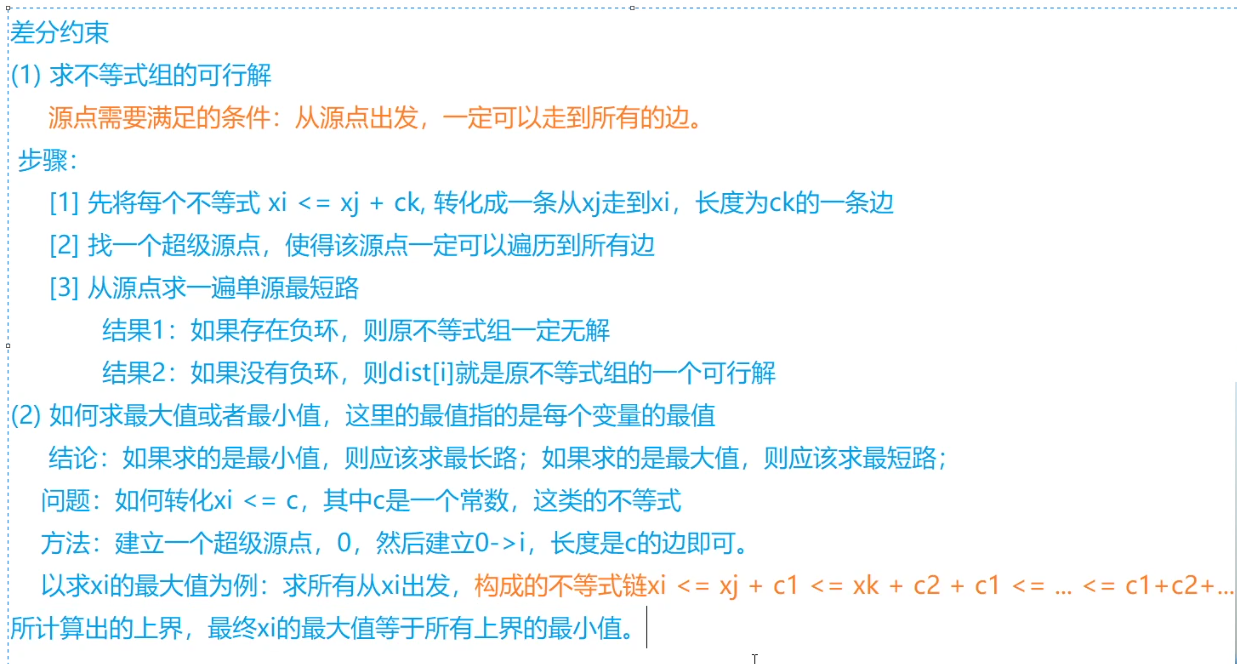
判断是否合法
例题:提高题库 183.小K的农场
#include <bits/stdc++.h>
using namespace std;
const int maxn = 10010;
const int maxm = 30010;
int n = 0, m = 0;
int h[maxn] = {}, to[maxm] = {}, nxt[maxm] = {}, w[maxm] = {}, tot = 0;
bool vis[maxn] = {};
int dis[maxn] = {};
void addedge(int x, int y, int z)
{
to[++tot] = y;
w[tot] = z;
nxt[tot] = h[x];
h[x] = tot;
}
//dfs版spfa
void spfa(int x)
{
vis[x] = true;
for(int i=h[x]; i; i=nxt[i])
{
int y = to[i];
if(dis[y] > dis[x] + w[i])
{
if(vis[y])
{
printf("No");
exit(0);
}
dis[y] = dis[x] + w[i];
spfa(y);
}
}
vis[x] = false;
}
int main()
{
int p = 0, a = 0, b = 0, c = 0;
scanf("%d%d", &n, &m);
for(int i=1; i<=m; i++)
{
scanf("%d", &p);
if(p == 1)
{
scanf("%d%d%d", &a, &b, &c);
addedge(a, b, -c);
}
else if(p == 2)
{
scanf("%d%d%d", &a, &b, &c);
addedge(b, a, c);
}
else
{
scanf("%d%d", &a, &b);
addedge(b, a, 0);
addedge(a, b, 0);
}
}
//建立超级源点
for(int i=1; i<=n; i++) addedge(0, i, 0);
//判断有无负环
memset(dis, 0x3f, sizeof(dis));
dis[0] = 0;
spfa(0);
printf("Yes");
}
求最小值
最近公共祖先(LCA)
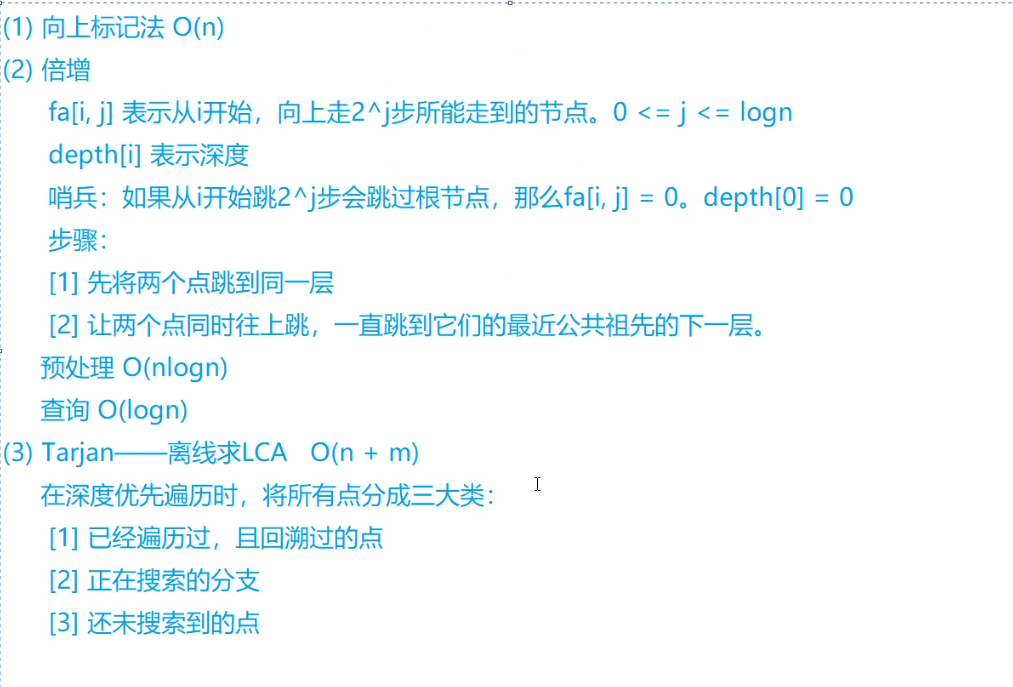
倍增法
倍增法为在线算法
例题:提高题库 315.Distance Queries 距离咨询
#include <bits/stdc++.h>
using namespace std;
const int maxn = 40010;
const int maxm = 80010;
int n = 0, m = 0, q = 0;
int h[maxn] = {}, nxt[maxm] = {}, to[maxm] = {}, w[maxm] = {}, tot = 0;
int f[maxn][30] = {}, dis[maxn] = {}, dep[maxn] = {};
void addedge(int x, int y, int z)
{
to[++tot] = y;
w[tot] = z;
nxt[tot] = h[x];
h[x] = tot;
}
//①该题中任意两个农场之间都有且只有一条路径
//所以可以指定任意一个点为根节点
//并且只要dfs的过程中更新路径,该路径即为两点间的距离
//②dfs的过程中可以顺便维护节点深度
void dfs(int x, int fa)
{
dep[x] = dep[fa] + 1;
f[x][0] = fa;
for(int i=h[x]; i; i=nxt[i])
{
int y = to[i];
if(y == fa) continue;
dis[y] = dis[x] + w[i];
dfs(y, x);
}
}
//倍增法求lca
int lca(int x, int y)
{
if(dep[x] < dep[y]) swap(x, y);
//x和y跳到同一深度
int d = dep[x] - dep[y];
for(int i=0; i<30; i++)
{
if(d & (1<<i)) x = f[x][i];
}
if(x == y) return x;
//x和y同时往上跳
for(int i=29; i>=0; i--)
{
if(f[x][i] != f[y][i])
{
x = f[x][i];
y = f[y][i];
}
if(f[x][0] == f[y][0]) break;
}
return f[x][0];
}
int main()
{
int x = 0, y = 0, z = 0;
char c;
scanf("%d%d", &n, &m);
for(int i=1; i<=m; i++)
{
scanf("%d%d%d %c", &x, &y, &z, &c);
addedge(x, y, z);
addedge(y, x, z);
}
dfs(1, 0);
//ST表初始化
for(int j=1; j<30; j++)
{
for(int i=1; i<=n; i++)
{
f[i][j] = f[f[i][j-1]][j-1];
}
}
scanf("%d", &q);
while(q--)
{
scanf("%d%d", &x, &y);
int t = lca(x, y);
printf("%d\n", dis[x] + dis[y] - 2 * dis[t]);
}
return 0;
}
tarjan算法求lca
简介: tarjan算法为离线算法,需要使用并查集记录某个节点的祖先节点
主要思路: 首先初始化每个节点的祖先节点为自身,任选一个节点进行\(dfs\),遍历完某个节点及其子节点后,将该点的父亲节点设置为该点的祖先节点,然后查询和这个点相关的所有询问,当另一端点\(v\)已经遍历过时,该端点\(v\)的祖先节点,即这两个点的最近公共祖先(\(lca\))。
具体实现:
1、保存查询信息时,注意双向,即\(u->\)和\(v->u\)都要保存
2、初始化并查集,将每个点的祖先设置为其自身
3、开始\(dfs\),遍历完每个节点即其子节点后,将该点的祖先节点设置为其父节点
4、遍历完某个点\(u\)的所有子节点后,开始查询与\(u\)点相关的询问,假设两个点为\((u, v)\),则可能出现以下情况
①\(v\)还没有遍历过。直接跳过,等待遍历到\(v\)时,再找\(u\)
②\(v\)为\(u\)的子节点。此时找\(v\)的祖先节点,祖先节点一定是\(u\),即他们的\(lca\)。
③\(v\)和\(u\)属于不同的子树。此时\(v\)和\(u\)一定处于一棵大的子树中,找\(v\)的祖先节点,就是该大子树的根节点,即他们的\(lca\)。
5、最后输出结果
时间复杂度: \(O(mα(m+n,n)+n)\),可近似认为是\(O(m+n)\)
例题: LG3379 【模板】最近公共祖先(LCA)
#include <bits/stdc++.h>
using namespace std;
const int maxn = 5e5 + 10;
const int maxm = 5e5 + 10;
int n = 0, m = 0, root = 0;
int h[maxn] = {}, to[maxn<<1] = {}, nxt[maxn<<1] = {}, tot = 0;
struct node
{
int v, idx; //指向的点和该询问的位置
};
vector<node> qry[maxn]; //存储查询信息
int fa[maxn] = {}; //并查集变量
int ans[maxm] = {}; //存储最终的答案
bool vis[maxn] = {}; //存储该节点是否已访问过
void addedge(int x, int y)
{
to[++tot] = y;
nxt[tot] = h[x];
h[x] = tot;
}
//找x的祖先
int findset(int x)
{
if(x == fa[x]) return fa[x];
return fa[x] = findset(fa[x]);
}
//求lca
void dfs(int x)
{
int y = 0;
vis[x] = true;
for(int i=h[x]; i; i=nxt[i])
{
y = to[i];
if(vis[y]) continue;
dfs(y);
fa[y] = x;
}
for(auto nd : qry[x])
{
if(vis[nd.v])
{
ans[nd.idx] = findset(nd.v);
}
}
}
int main()
{
int x = 0, y = 0;
scanf("%d%d%d", &n, &m, &root);
for(int i=1; i<n; i++)
{
scanf("%d%d", &x, &y);
addedge(x, y);
addedge(y, x);
}
for(int i=1; i<=m; i++)
{
scanf("%d%d", &x, &y);
qry[x].push_back({y, i});
qry[y].push_back({x, i});
}
for(int i=1; i<=n; i++) fa[i] = i;
dfs(root);
for(int i=1; i<=m; i++) printf("%d\n", ans[i]);
return 0;
}
树链剖分
重链剖分
例题
例题:洛谷: P3384 【模板】重链剖分/树链剖分
#include <bits/stdc++.h>
using namespace std;
#define lson (rt << 1)
#define rson (rt << 1 | 1)
const int maxn = 1e5 + 10, maxm = 1e5 + 10;
//r:根节点 p:模数
int n = 0, m = 0, r = 0, p = 0;
int a[maxn] = {};
//邻接链表变量
int h[maxn] = {}, nxt[maxn<<1] = {}, to[maxn<<1] = {}, tot = 0;
//重链剖分变量
//fa(x) 表示节点 x 在树上的父亲
//dep(x) 表示节点 x 在树上的深度
//siz(x) 表示节点 x 的子树的节点个数
//son(x) 表示节点 x 的 重儿子
//top(x) 表示节点 x 所在 重链 的顶部节点(深度最小)
//dfn(x) 表示节点 x 的 DFS 序,也是其在线段树中的编号
//rnk(x) 表示 DFS 序所对应的节点编号,有 rnk(dfn(x))=x
//cnt 用来求dfs序
int fa[maxn] = {}, dep[maxn] = {}, siz[maxn] = {}, son[maxn] = {}, top[maxn] = {};
int dfn[maxn] = {}, rnk[maxn] = {}, cnt = 0;
//线段树变量
struct node
{
int l, r, sum, lazy;
}tree[maxn<<2];
void pushup(int rt)
{
tree[rt].sum = (tree[lson].sum + tree[rson].sum) % p;
}
//把当前节点rt的延迟标记下放到左右儿子
void pushdown(int rt)
{
if(tree[rt].lazy)//此节点有延迟标记
{
int lz = tree[rt].lazy;
tree[rt].lazy = 0;//记住要清零
tree[lson].lazy = (tree[lson].lazy + lz) % p;
tree[rson].lazy = (tree[rson].lazy + lz) % p;
tree[lson].sum = (tree[lson].sum + lz * (tree[lson].r - tree[lson].l + 1) % p) % p;
tree[rson].sum = (tree[rson].sum + lz * (tree[rson].r - tree[rson].l + 1) % p) % p;
}
}
//建树
void Build(int rt, int l, int r)
{
tree[rt].l = l;
tree[rt].r = r;//节点信息初始化
if(l == r)//到叶节点
{
tree[rt].sum = a[rnk[l]] % p;
return;
}
int mid = (l + r) >> 1;
Build(lson, l, mid);
Build(rson, mid+1, r);
pushup(rt);//子树建好后,回溯时更新父节点信息
}
void Update(int rt, int l, int r, int val)
{
//更新区间完全覆盖节点表示的区间
if(l<=tree[rt].l && tree[rt].r<=r)
{
tree[rt].lazy = (tree[rt].lazy + val) % p;
tree[rt].sum = (tree[rt].sum + val * (tree[rt].r - tree[rt].l + 1) % p) % p;
return;
}
//如果不能完全覆盖,此时需要向下递归,要下放标记
pushdown(rt);
int mid = (tree[rt].l + tree[rt].r) >> 1;
if(l <= mid) Update(lson, l, r, val);
if(r > mid) Update(rson, l, r, val);
pushup(rt);
}
//当前节点为rt,要查询的区间是[l, r]
int Query(int rt, int l, int r)
{
int ret = 0;
//如果节点表示的区间是查询区间的真子集
if(l<=tree[rt].l && tree[rt].r<=r)
{
return tree[rt].sum % p;
}
//如果不能完全覆盖,此时需要向下递归,要下放标记
pushdown(rt);
int mid = (tree[rt].l + tree[rt].r) >> 1;
if(l <= mid) ret = (ret + Query(lson, l, r)) % p;
if(r > mid) ret = (ret + Query(rson, l, r)) % p;
return ret;
}
void addedge(int x, int y)
{
to[++tot] = y;
nxt[tot] = h[x];
h[x] = tot;
}
//求出 fa(x),dep(x),siz(x),son(x)
void dfs1(int x)
{
son[x] = -1;
siz[x] = 1;
for(int i=h[x]; i; i=nxt[i])
{
int y = to[i];
if(!dep[y])
{
dep[y] = dep[x] + 1;
fa[y] = x;
dfs1(y);
siz[x] += siz[y];
if(son[x]==-1 || siz[y]>siz[son[x]]) son[x] = y;
}
}
}
//求出 top(x),dfn(x),rnk(x)
void dfs2(int x, int t)
{
top[x] = t;
cnt++;
dfn[x] = cnt;
rnk[cnt] = x;
if(son[x] == -1) return; //x为叶子节点
dfs2(son[x], t);// 优先对重儿子进行 DFS,可以保证同一条重链上的点 DFS 序连续
for(int i=h[x]; i; i=nxt[i])
{
int y = to[i];
//y为轻儿子时,单独开一条链,y为链顶端点
if(y!=son[x] && y!=fa[x]) dfs2(y, y);
}
}
void add1(int x, int y, int val)
{
//跳重链
while(top[x] != top[y])
{
if(dep[top[x]] < dep[top[y]]) swap(x, y);
Update(1, dfn[top[x]], dfn[x], val);
x = fa[top[x]];
}
//已跳到同一条重链
if(dep[x] > dep[y]) swap(x, y);
Update(1, dfn[x], dfn[y], val);
}
int query1(int x, int y)
{
int ret = 0;
//跳重链
while(top[x] != top[y])
{
if(dep[top[x]] < dep[top[y]]) swap(x, y);
ret = (ret + Query(1, dfn[top[x]], dfn[x])) % p;
x = fa[top[x]];
}
//已跳到同一条重链
if(dep[x] > dep[y]) swap(x, y);
ret = (ret + Query(1, dfn[x], dfn[y])) % p;
return ret;
}
int main()
{
// freopen("P3384_11.in", "r", stdin);
int op = 0, x = 0, y = 0, z = 0;
scanf("%d%d%d%d", &n, &m, &r, &p);
for(int i=1; i<=n; i++) scanf("%d", &a[i]);
for(int i=1; i<n; i++)
{
scanf("%d%d", &x, &y);
addedge(x, y);
addedge(y, x);
}
//执行重链剖分,两遍 DFS 预处理出这些值,
//第一次 DFS 求出 fa(x),dep(x),siz(x),son(x)
dep[r] = 1;
dfs1(r);
//第二次 DFS 求出 top(x),dfn(x),rnk(x)。
dfs2(r, r);
//针对dfn序建树
Build(1, 1, cnt);
while(m--)
{
scanf("%d", &op);
if(op == 1)
{
scanf("%d%d%d", &x, &y, &z);
add1(x, y, z);
}
else if(op == 2)
{
scanf("%d%d", &x, &y);
int ans = query1(x, y);
printf("%d\n", ans);
}
else if(op == 3)
{
scanf("%d%d", &x, &z);
Update(1, dfn[x], dfn[x]+siz[x]-1, z);
}
else if(op == 4)
{
scanf("%d", &x);
int ans = Query(1, dfn[x], dfn[x]+siz[x]-1);
printf("%d\n", ans);
}
}
return 0;
}
Tarjan
一些概念
无向连通图的搜索树:在无向连通图中任选一个节点出发进行深度优先遍历,每个点只访问一次。所有发生递归的边\((x,y)\)(换言之,从\(x\)到\(y\)是对\(y\)的第一次访问)构成一棵树,我们把他称为"无向连通图的搜索树"。

时间戳:在图的深度优先遍历过程中,按照每个节点第一次被访问的时间顺序,依次给予\(N\)个节点\(1\)~\(N\)的整数标记,该标记被称为“时间戳”,记为\(dfn[x]\)
追溯值: 设\(subtree(x)\)表示搜索树中以\(x\)为根的子树。\(low[x]\)定义为以下节点的时间戳的最小值
1、\(subtree(x)\)中的节点
2、通过1条不在搜索树上的边,能够到达\(subtree(x)\)的节点。
计算追溯值:
先令\(low[x]=dfn[x]\),然后考虑从\(x\)出发的每条边\((x, y)\)
1、树边,若在搜索树上\(x\)是\(y\)的父节点,则令\(low[x]=min(low[x],low[y])\)
2、非树边,若无向边\((x, y)\)不是搜索树上的边,则令\(low[x]=min(low[x],dfn[y])\)
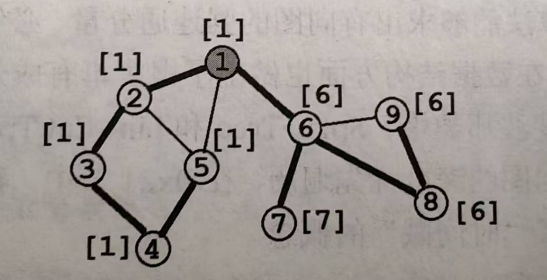
割边
割边或桥:对于无向图 \(G=(V, E)\),若对于\(e∈E\),从图中删去边\(e\)之后,\(G\)分裂成两个不相连的子图,则称\(e\)为\(G\)的割边或桥。
ps:树中所有边都是桥
概念:无向边\((x, y)\)是桥,当且仅当搜索树上存在\(x\)的一个子节点\(y\),满足\(dfn[x]<low[y]\),即追溯不到更小的点
ps:桥一定是搜索树中的边,并且一个简单环中的边一定都不是桥
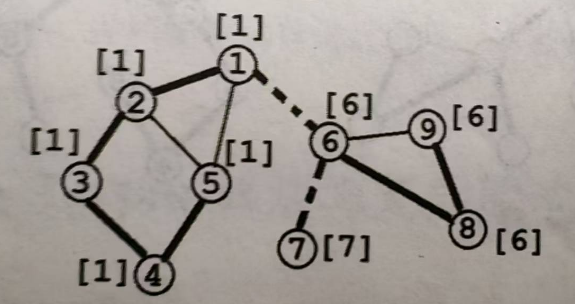
上图有两条割边,1->6和6->7
割边算法模板
#include <bits/stdc++.h>
using namespace std;
const int maxn = 100010;
const int maxm = 1000010;
int n = 0, m = 0;
//存图
int h[maxn] = {}, to[maxm] = {}, nxt[maxm] = {}, tot = 0;
//dfn:时间戳 low:追溯值
int dfn[maxn] = {}, low[maxn] = {}, num = 0;
bool bridge[maxm] = {};
void addedge(int x, int y)
{
to[++tot] = y;
nxt[tot] = h[x];
h[x] = tot;
}
void tarjan(int x, int in_edge)
{
dfn[x] = low[x] = ++num;
for(int i=h[x]; i; i=nxt[i])
{
int y = to[i];
if(!dfn[y]) //树边
{
tarjan(y, i);
low[x] = min(low[x], low[y]);
//此时已经遍历完x的子节点,又回溯到了x
if(dfn[x] < low[y]) //说明经过(x,y)边,无法到达比x更早的点
{
//i和i^1是同一条边
bridge[i] = bridge[i^1] = true;
}
}
//i == (in_edge ^ 1)表示与i是同一条边
//i != (in_edge ^ 1)说明是非树边
else if(i != (in_edge ^ 1))
{
low[x] = min(low[x], dfn[y]);
}
}
}
int main()
{
int x = 0, y = 0;
//这里是为了保证i和i^1是同一条边
//这样边的编号从2开始,2/3为一对,4/5为一对,以此类推
tot = 1;
scanf("%d%d", &n, &m);
for(int i=1; i<=m; i++)
{
scanf("%d%d", &x, &y);
addedge(x, y);
addedge(y, x);
}
for(int i=1; i<=n; i++)
{
if(!dfn[i]) tarjan(i, 0);
}
for(int i=2; i<tot; i++)
{
if(bridge[i])
{
printf("%d %d\n", to[i^1], to[i]);
}
}
return 0;
}
割点
割点:对于无向图 \(G=(V, E)\),若对于\(x∈V\),从图中删去节点\(x\)以及所有与\(x\)关联的边之后,\(G\)分裂成两个或两个以上不相连的子图,则称\(x\)为\(G\)的割点。
ps:树中度为1的点(叶子结点)都不是割点,其他都是割点
条件:若\(x\)不是搜索树的根节点(深度优先遍历的起点),则\(x\)是割点当且仅当搜索树上存在\(x\)的一个子节点\(y\),满足:\(dfn[x]<=low[y]\)
特点:
1、若\(x\)是搜索树的根节点,则\(x\)是割点当且仅当搜索树上存在至少两个子节点\(y1,y2\)满足上述条件。
2、下面非空,即不能是叶子节点
3、上下只能通过\(x\)相通,即y子树不能追溯到比x更早的点
下图中共有两个割点,分别是时间戳为1和6的两个点
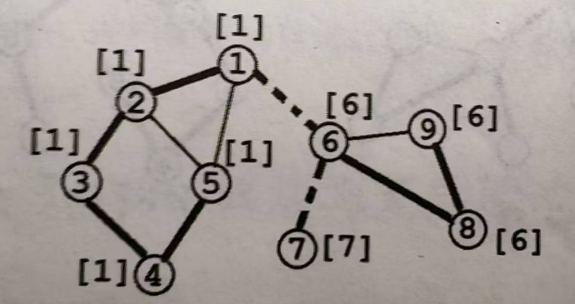
割点算法模板
#include <bits/stdc++.h>
using namespace std;
const int maxn = 100010;
const int maxm = 1000010;
int n = 0, m = 0;
//存图
int h[maxn] = {}, to[maxm] = {}, nxt[maxm] = {}, tot = 0;
//dfn:时间戳 low:追溯值
int dfn[maxn] = {}, low[maxn] = {}, num = 0;
int root = 0;
bool cut[maxn] = {};
int cnt = 0;
void addedge(int x, int y)
{
to[++tot] = y;
nxt[tot] = h[x];
h[x] = tot;
}
void tarjan(int x)
{
dfn[x] = low[x] = ++num;
int flag = 0; //记录x有多少个不能回溯到x之前的子节点
for(int i=h[x]; i; i=nxt[i])
{
int y = to[i];
if(!dfn[y]) //树边
{
tarjan(y);
low[x] = min(low[x], low[y]);
//此时已经遍历完x的子节点,又回溯到了x
if(dfn[x] <= low[y]) //y无法到达比x更早的点
{
flag++;
if(x != root || flag > 1)
{
//如果统计割点数量,这里要判断一下是否已标记
//因为一个割点可能会被重复访问
//下图中点6就会被访问两次
if(!cut[x])
{
cut[x] = true;
cnt++;
}
}
}
}
else
{
low[x] = min(low[x], dfn[y]);
}
}
}
int main()
{
int x = 0, y = 0;
scanf("%d%d", &n, &m);
for(int i=1; i<=m; i++)
{
scanf("%d%d", &x, &y);
if(x == y) continue;
addedge(x, y);
addedge(y, x);
}
for(int i=1; i<=n; i++)
{
if(!dfn[i])
{
root = i; //方便后面判断是否为根节点
tarjan(i);
}
}
for(int i=1; i<=n; i++)
{
if(cut[i]) printf("%d ", i);
}
printf("are cut-vertexes");
return 0;
}
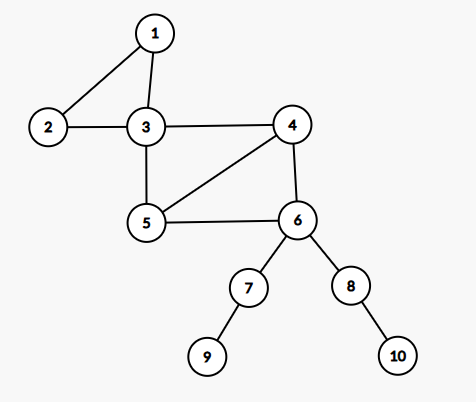
无向图的双连通分量
点双连通图:若一张无向连通图不存在割点,则称它为“点双连通图”
边双连通图:若一张无向连通图不存在桥,则称他为“边双连通图”
点双连通分量:无向图的极大点双连通子图被称为“点双连通分量”\(v-DCC\)
边双连通分量:无向连通图的极大边双连通子图被称为“边双连通分量”简称\(e-DCC\)
一张无向连通图是“点双连通图”,当且仅当满足下列两个条件之一:
1、图的顶点数不超过2。(ps:意思是当一个图仅有1个或2个顶点时,一定是点双)
2、图中任意两点都同时包含在至少一个简单环中。(ps:“简单环”指的是不自交的环,也就是我们通常画出的环)
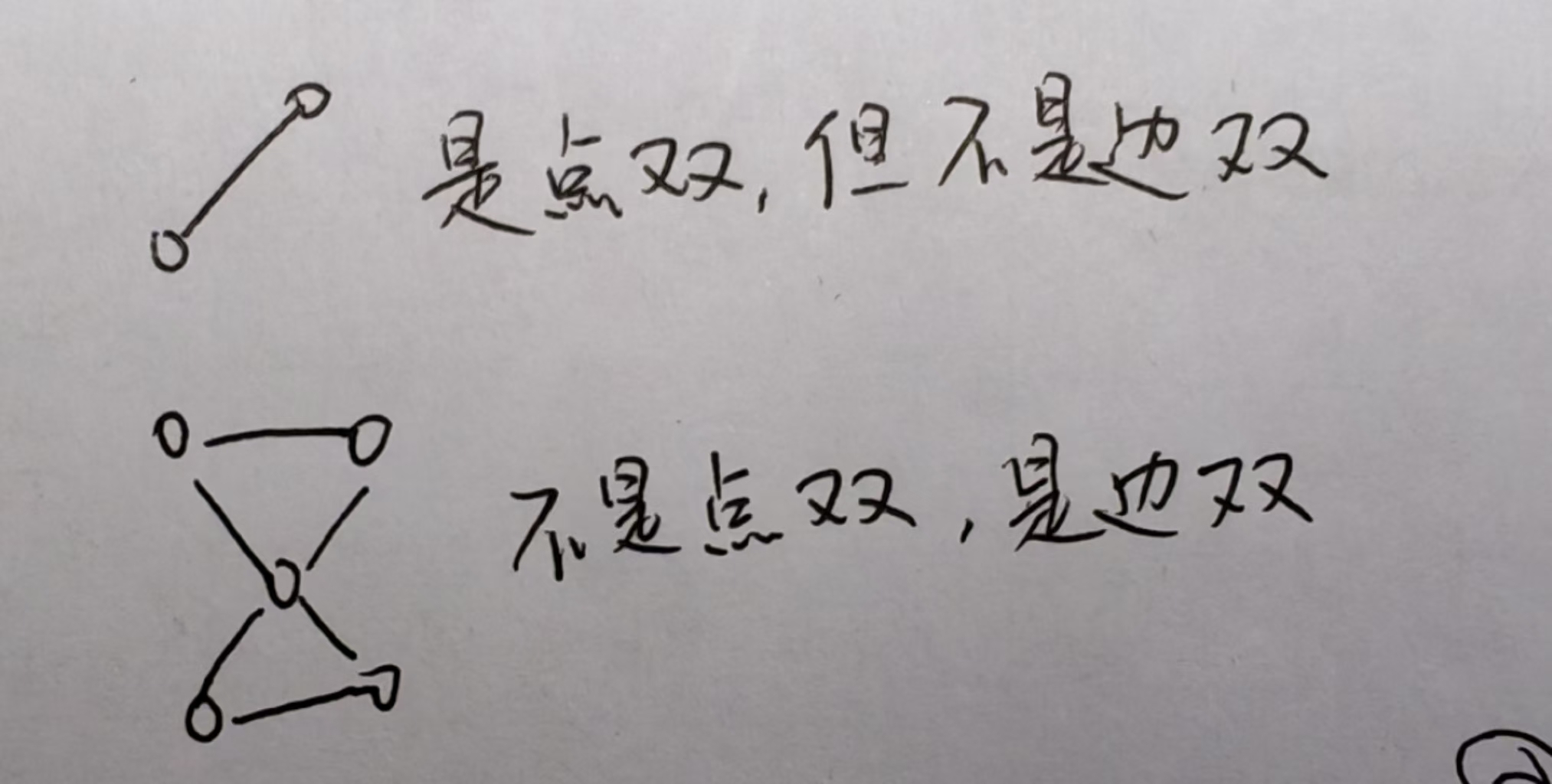
边双连通分量(e-DCC)的求法模板:

算法:先用\(Tarjan\)算法标记出所有的桥边。然后,再对整个无向图执行一次深度优先遍历(遍历的过程中不访问桥边),划分出每个连通块。
下面的代码在\(Tarjan\)求桥的基础上,计算出数组\(c\),\(c[x]\)表示节点\(x\)所属的“边双连通分量”的编号
#include <bits/stdc++.h>
using namespace std;
const int maxn = 100010;
const int maxm = 1000010;
int n = 0, m = 0;
//存图
int h[maxn] = {}, to[maxm] = {}, nxt[maxm] = {}, tot = 0;
//dfn:时间戳 low:追溯值
int dfn[maxn] = {}, low[maxn] = {}, num = 0;
bool bridge[maxm] = {};
int c[maxn] = {}, dcc = 0;
void addedge(int x, int y)
{
to[++tot] = y;
nxt[tot] = h[x];
h[x] = tot;
}
void tarjan(int x, int in_edge)
{
dfn[x] = low[x] = ++num;
for(int i=h[x]; i; i=nxt[i])
{
int y = to[i];
if(!dfn[y]) //树边
{
tarjan(y, i);
low[x] = min(low[x], low[y]);
//此时已经遍历完y节点
if(dfn[x] < low[y]) //说明经过(x,y)边,无法到达比x更早的点
{
//i和i^1是同一条边
bridge[i] = bridge[i^1] = true;
}
}
//i == (in_edge ^ 1)表示与i是同一条边
//i != (in_edge ^ 1)说明是非树边
else if(i != (in_edge ^ 1))
{
low[x] = min(low[x], dfn[y]);
}
}
}
void dfs(int x)
{
c[x] = dcc;
for(int i=h[x]; i; i=nxt[i])
{
int y = to[i];
if(c[y] || bridge[i]) continue;
dfs(y);
}
}
int main()
{
int x = 0, y = 0;
//这里是为了保证i和i^1是同一条边
//这样边的编号从2开始,2/3为一对,4/5为一对,以此类推
tot = 1;
scanf("%d%d", &n, &m);
for(int i=1; i<=m; i++)
{
scanf("%d%d", &x, &y);
addedge(x, y);
addedge(y, x);
}
for(int i=1; i<=n; i++)
{
if(!dfn[i]) tarjan(i, 0);
}
for(int i=1; i<=n; i++)
{
if(!c[i])
{
++dcc;
dfs(i);
}
}
printf("There are %d e-DCCs.\n", dcc);
for(int i=1; i<=n; i++)
{
printf("%d belongs to DCC %d.\n", i, c[i]);
}
return 0;
}
e-DCC的缩点模板:
把每个\(e-DCC\)看做一个节点,把桥边\((x, y)\)看做连接编号为\(c[x]\)和\(c[y]\)的\(e-DCC\)对应节点的无向边,会产生一棵树(若原来的无向图不连通,则产生森林)。这种把\(e-DCC\)收缩为一个节点的方法就称为“缩点”。
下面的代码在\(Tarjan\)求桥、求\(e-DCC\)的参考程序基础上,把\(e-DCC\)缩点,构成一棵新的树(或森林),存储在另一个邻接表中
#include <bits/stdc++.h>
using namespace std;
const int maxn = 100010;
const int maxm = 1000010;
int n = 0, m = 0;
//存原图
int h[maxn] = {}, to[maxm] = {}, nxt[maxm] = {}, tot = 0;
//dfn:时间戳 low:追溯值
int dfn[maxn] = {}, low[maxn] = {}, num = 0;
bool bridge[maxm] = {};
int c[maxn] = {}, dcc = 0;
//存缩点后的图
int hc[maxn] = {}, toc[maxm] = {}, nxtc[maxn] = {}, totc = 0;
void addedge(int x, int y)
{
to[++tot] = y;
nxt[tot] = h[x];
h[x] = tot;
}
void addedge_c(int x, int y)
{
toc[++totc] = y;
nxtc[totc] = hc[x];
hc[x] = totc;
}
void tarjan(int x, int in_edge)
{
dfn[x] = low[x] = ++num;
for(int i=h[x]; i; i=nxt[i])
{
int y = to[i];
if(!dfn[y]) //树边
{
tarjan(y, i);
low[x] = min(low[x], low[y]);
//此时已经遍历完y节点
if(dfn[x] < low[y]) //说明经过(x,y)边,无法到达比x更早的点
{
//i和i^1是同一条边
bridge[i] = bridge[i^1] = true;
}
}
//i == (in_edge ^ 1)表示与i是同一条边
//i != (in_edge ^ 1)说明是非树边
else if(i != (in_edge ^ 1))
{
low[x] = min(low[x], dfn[y]);
}
}
}
void dfs(int x)
{
c[x] = dcc;
for(int i=h[x]; i; i=nxt[i])
{
int y = to[i];
if(c[y] || bridge[i]) continue;
dfs(y);
}
}
int main()
{
int x = 0, y = 0;
//这里是为了保证i和i^1是同一条边
//这样边的编号从2开始,2/3为一对,4/5为一对,以此类推
tot = 1;
scanf("%d%d", &n, &m);
for(int i=1; i<=m; i++)
{
scanf("%d%d", &x, &y);
addedge(x, y);
addedge(y, x);
}
for(int i=1; i<=n; i++)
{
if(!dfn[i]) tarjan(i, 0);
}
for(int i=1; i<=n; i++)
{
if(!c[i])
{
++dcc;
dfs(i);
}
}
printf("There are %d e-DCCs.\n", dcc);
for(int i=1; i<=n; i++)
{
printf("%d belongs to DCC %d.\n", i, c[i]);
}
totc = 1;
for(int i=2; i<=tot; i++)
{
//第i条边为x->y,第i^1条边为y->x
int x = to[i^1], y = to[i];
if(c[x] == c[y]) continue;
addedge_c(c[x], c[y]);
}
printf("缩点之后的森林,点数%d,边数%d\n", dcc, totc / 2);
for(int i=2; i<totc; i+=2)
{
printf("%d %d\n", toc[i^1], toc[i]);
}
return 0;
}
点双连通分量(v-DCC)的求法模板:
定义:
1、若某个节点为孤立点,则它自己单独构成一个\(v-DCC\)。
2、除了孤立点外,点双连通分量的大小至少为2.
3、根据\(v-DCC\)定义中的“极大”性,虽然桥不属于任何\(e-DCC\),但是割点可能属于多个\(v-DCC\)。
下面的无向图共有2个割点,4个“点双连通分量”
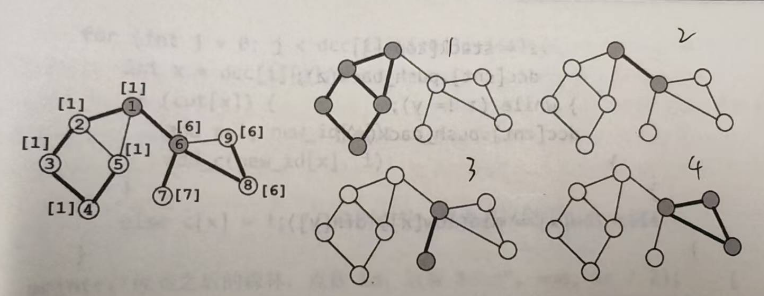
算法简介:
1、当一个节点第一次被访问时,把该节点入栈
2、当割点判定法则中的条件\(dfn[x]<=low[y]\)成立时,无论x是否为根,都要
(1)从栈顶不断弹出节点,直至节点y被弹出
(2)刚才弹出的所有节点与节点\(x\)一起构成一个\(v-DCC\)。
下面的程序在求割点的同时,计算出\(vector\)数组\(dcc\),\(dcc[i]\)保存编号为\(i\)的\(v-DCC\)中的所有节点
#include <bits/stdc++.h>
using namespace std;
const int maxn = 100010;
const int maxm = 1000010;
int n = 0, m = 0;
//存图
int h[maxn] = {}, to[maxm] = {}, nxt[maxm] = {}, tot = 0;
//dfn:时间戳 low:追溯值
int dfn[maxn] = {}, low[maxn] = {}, num = 0;
int root = 0;
bool cut[maxn] = {}; //cut[x]表示x是否为割点
//cnt表示点双的数量
int stk[maxn] = {}, top = 0, cnt = 0;
vector<int> dcc[maxn]; //dcc[x]表示第x个点双中包含的节点
void addedge(int x, int y)
{
to[++tot] = y;
nxt[tot] = h[x];
h[x] = tot;
}
void tarjan(int x)
{
dfn[x] = low[x] = ++num;
int flag = 0; //记录x有多少个不能回溯到x之前的子节点
stk[++top] = x;
if(x == root && h[x] == 0) //孤立点
{
dcc[++cnt].push_back(x);
return;
}
for(int i=h[x]; i; i=nxt[i])
{
int y = to[i];
if(!dfn[y]) //树边
{
tarjan(y);
low[x] = min(low[x], low[y]);
//此时已经遍历完x的子节点,又回溯到了x
if(dfn[x] <= low[y]) //y无法到达比x更早的点
{
flag++;
if(x != root || flag > 1) cut[x] = true;
cnt++;
int z = 0;
do
{
z = stk[top--];
dcc[cnt].push_back(z);
}while(z != y);
dcc[cnt].push_back(x);
}
}
else
{
low[x] = min(low[x], dfn[y]);
}
}
}
int main()
{
int x = 0, y = 0;
scanf("%d%d", &n, &m);
for(int i=1; i<=m; i++)
{
scanf("%d%d", &x, &y);
if(x == y) continue;
addedge(x, y);
addedge(y, x);
}
for(int i=1; i<=n; i++)
{
if(!dfn[i])
{
root = i; //方便后面判断是否为根节点
tarjan(i);
}
}
for(int i=1; i<=n; i++)
{
if(cut[i]) printf("%d ", i);
}
printf("are cut-vertexes");
for(int i=1; i<=cnt; i++)
{
printf("v-DCC #%d:", i);
for(int j=0; j<dcc[i].size(); j++)
{
printf(" %d", dcc[i][j]);
}
printf("\n");
}
return 0;
}
v-DCC的缩点模板:
v-DCC的缩点比e-DCC要复杂一些——因为一个割点可能属于多个v-DCC。
设图中共有p个割点和t个v-DCC。我们建立一张包含p+t个节点的新图,把每个v-DCC和每个割点都作为新图中的节点,并在每个割点与包含它的所有v-DCC之间连边。
容易发现,这张新图其实是一棵树(或森林),如下图所示:

#include <bits/stdc++.h>
using namespace std;
const int maxn = 100010;
const int maxm = 1000010;
int n = 0, m = 0;
//存图
int h[maxn] = {}, to[maxm] = {}, nxt[maxm] = {}, tot = 0;
//dfn:时间戳 low:追溯值
int dfn[maxn] = {}, low[maxn] = {}, num = 0;
int root = 0;
bool cut[maxn] = {}, c[maxn] = {}; //cut[x]表示x是否为割点,c[x]表示x属于哪个v-DCC
//cnt表示点双的数量
int stk[maxn] = {}, top = 0, cnt = 0;
vector<int> dcc[maxn]; //dcc[x]表示第x个点双中包含的节点
int new_id[maxn] = {}; //new_id[x]表示割点x的新编号
int hc[maxn] = {}, toc[maxm] = {}, nxtc[maxm] = {}, totc = 0;
void addedge(int x, int y)
{
to[++tot] = y;
nxt[tot] = h[x];
h[x] = tot;
}
void addedge_c(int x, int y)
{
toc[++totc] = y;
nxtc[totc] = h[x];
hc[x] = totc;
}
void tarjan(int x)
{
dfn[x] = low[x] = ++num;
int flag = 0; //记录x有多少个不能回溯到x之前的子节点
stk[++top] = x;
if(x == root && h[x] == 0) //孤立点
{
dcc[++cnt].push_back(x);
return;
}
for(int i=h[x]; i; i=nxt[i])
{
int y = to[i];
if(!dfn[y]) //树边
{
tarjan(y);
low[x] = min(low[x], low[y]);
//此时已经遍历完x的子节点,又回溯到了x
if(dfn[x] <= low[y]) //y无法到达比x更早的点
{
flag++;
if(x != root || flag > 1) cut[x] = true;
cnt++;
int z = 0;
do
{
z = stk[top--];
dcc[cnt].push_back(z);
}while(z != y);
dcc[cnt].push_back(x);
}
}
else
{
low[x] = min(low[x], dfn[y]);
}
}
}
int main()
{
int x = 0, y = 0;
scanf("%d%d", &n, &m);
for(int i=1; i<=m; i++)
{
scanf("%d%d", &x, &y);
if(x == y) continue;
addedge(x, y);
addedge(y, x);
}
for(int i=1; i<=n; i++)
{
if(!dfn[i])
{
root = i; //方便后面判断是否为根节点
tarjan(i);
}
}
for(int i=1; i<=n; i++)
{
if(cut[i]) printf("%d ", i);
}
printf("are cut-vertexes");
for(int i=1; i<=cnt; i++)
{
printf("v-DCC #%d:", i);
for(int j=0; j<dcc[i].size(); j++)
{
printf(" %d", dcc[i][j]);
}
printf("\n");
}
//给每个割点一个新的编号(编号从cnt+1开始)
num = cnt;
for(int i=1; i<=n; i++)
{
if(cut[i]) new_id[i] = ++num;
}
//建新图,从每个v-DCC到它包含的所有割点连边
totc = 1;
for(int i=1; i<=cnt; i++)
{
for(int j=0; j<dcc[i].size(); j++)
{
int x = dcc[i][j];
if(cut[x])
{
addedge_c(i, new_id[x]); //i就是该v-DCC的编号,连线
addedge_c(new_id[x], i);
}
else c[x] = i;
}
}
printf("缩点之后的森林,点数%d,边数%d\n", num, totc / 2);
printf("编号1~%d的为原图的v-DCC,编号>%d的为原图割点\n", cnt, cnt);
for(int i=2; i<totc; i+=2)
{
printf("%d %d\n", toc[i^1], toc[i]);
}
return 0;
}
有向图连通性
流图:给定有向图\(G=(V, E)\),若存在\(r∈V\),满足从\(r\)出发能够到达V中所有的点,则称\(G\)是一个“流图”,记为\((G, r)\),其中\(r\)称为流图的源点
流图\((G, r)\)的搜索树:在一个流图\((G, r)\)上从\(r\)出发进行深度优先遍历,每个点只访问一次。所有发生递归的边\((x, y)\)(换言之,从\(x\)到\(y\)是对\(y\)的第一次访问)构成一棵以\(r\)为根的数,我们把他称为流图\((G, r)\)的搜索树
时间戳: 在深度优先遍历的过程中,按照每个节点第一次被访问的时间顺序,一次给予流图中的\(N\)个节点1~\(N\)的整数标记,该标记被称为时间戳,记为\(dfn[x]\)
流图中的每条有向边\((x, y)\)必然是以下四种之一:
1、树枝边:指搜索树中的边,即\(x\)是\(y\)的父节点
2、前向边:指搜索树中\(x\)是\(y\)的祖先节点(没啥用,因为搜索树上本来就存在\(x\)到\(y\)的路径)
3、后向边:指搜索树中\(y\)是\(x\)的祖先节点(非常有用,因为它可以和搜索树上从\(y\)到\(x\)的路径一起构成环)
4、横叉边:指除了以上三种情况之外的边,他一定满足\(dfn[y]<dfn[x]\)(视情况而定,如果从\(y\)出发能找到一条路径回到\(x\)的祖先节点,那么\((x, y)\)就是有用的)
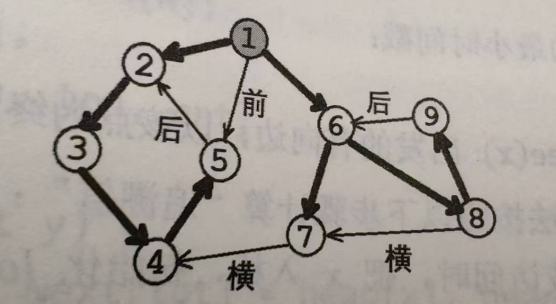

强连通图:给定一张有向图,若对于图中任意两个节点\(x,y\),既存在从\(x\)到\(y\)的路径,也存在从\(y\)到\(x\)的路径,则称该有向图是“强连通图”
强联通分量:有向图的极大强联通子图被称为“强联通分量”,简称“SCC”
追溯值: 设\(subtree(x)\)表示流图的搜索树中以\(x\)为根的子树。\(x\)的追溯值\(low[x]\)定义为满足以下条件的节点的最小时间戳:
1、该点在栈中(即遍历过该点)
2、存在一条从\(subtree(x)\)出发的有向边,以该点为终点(即存在横向边或后向边能到达该点)
追溯值的计算:
1、当节点\(x\)第一次被访问时,把\(x\)入栈,初始化\(low[x]=dfn[x]\)
2、扫描从\(x\)出发的每条边\((x, y)\)
(1)若\(y\)没被访问过,则说明\((x, y)\)是树枝边,递归访问\(y\),从\(y\)回溯之后,令\(low[x]=min(low[x], low[y])\)
(2)若\(y\)被访问过并且\(y\)在栈中,则说明\((x, y)\)是后向边,则令\(low[x]=min(low[x], dfn[y])\)
求强连通分量: 从\(x\)回溯之前,判断是否有\(low[x]=dfn[x]\)(说明\(subtree(x)\)追溯不到更高点了,此时出栈,则在最高点时出栈)。若成立,则不断从栈中弹出节点,直至\(x\)出栈。
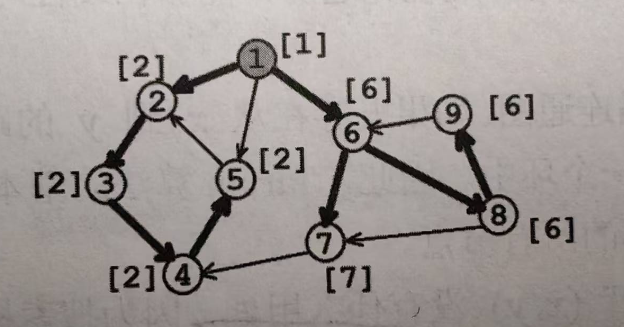
上图共有4个强联通分量(scc),分别是(2,3,4,5)(7)(6,8,9)(1)
强联通分量判定法则:
若从\(x\)回溯前,有\(low[x]=dfn[x]\)成立,则栈中从\(x\)到栈顶的所有节点构成一个强联通分量
scc算法模板:
下面的程序实现了\(Tarjan\)算法,求出数组\(c\),其中\(c[x]\)表示\(x\)所在的强连通分量的编号。另外,它还求出了\(vector\)数组\(scc\),\(scc[i]\)记录了编号为\(i\)的强连通分量中的所有节点。整张图同有\(cnt\)个强连通分量
#include <bits/stdc++.h>
using namespace std;
const int maxn = 100010;
const int maxm = 1000010;
int n = 0, m = 0;
//存图
int h[maxn] = {}, to[maxm] = {}, nxt[maxm] = {}, tot = 0;
//dfn:时间戳 low:追溯值
int dfn[maxn] = {}, low[maxn] = {}, num = 0;
//stk:数组表示栈
//ins[x]:表示x是否在栈中
//c[x]:表示x属于哪个scc
int stk[maxn] = {}, top = 0, ins[maxn] = {}, c[maxn] = {}, cnt = 0;
//scc[x]:表示第x个scc中的点
vector<int>scc[maxn] = {};
void addedge(int x, int y)
{
to[++tot] = y;
nxt[tot] = h[x];
h[x] = tot;
}
void tarjan(int x)
{
int y = 0;
dfn[x] = low[x] = ++num; //初始是时间戳等于追溯值
stk[++top] = x;
ins[x] = 1;
for(int i=h[x]; i; i=nxt[i])
{
y = to[i];
if(!dfn[y])
{
tarjan(y);
//树枝边,回溯是更新low[x]
low[x] = min(low[x], low[y]);
}
else if(ins[y]) //在栈中,即表示之前访问过
{
//横向边或后向边
low[x] = min(low[x], dfn[y]);
}
}
if(dfn[x] == low[x])
{
cnt++;
do
{
y = stk[top--]; //出栈
ins[y] = 0;
c[y] = cnt; //标记该点属于哪个scc
scc[cnt].push_back(y); //将该点加入对应scc的容器
}while(x != y);
}
}
int main()
{
int x = 0, y = 0;
scanf("%d%d", &n, &m);
for(int i=1; i<=m; i++)
{
scanf("%d%d", &x, &y);
addedge(x, y);
}
for(int i=1; i<=n; i++)
{
if(!dfn[i]) tarjan(i);
}
return 0;
}
scc缩点模板:
#include <bits/stdc++.h>
using namespace std;
/*
1、求出该图中的强联通分量scc
2、将scc进行缩点后,形成一个新图
*/
const int maxn = 500010;
const int maxm = 500010;
int n = 0, m = 0;
int h[maxn] = {}, to[maxm] = {}, nxt[maxm] = {}, tot = 0;
int dfn[maxn] = {}, low[maxn] = {}, num = 0;
int stk[maxn] = {}, top = 0, ins[maxn] = {}, cnt = 0, c[maxn] = {};
vector<int> scc[maxn] = {};
int hc[maxn] = {}, toc[maxm] = {}, nxtc[maxm] = {}, totc = 0;
void addedge(int x, int y)
{
to[++tot] = y;
nxt[tot] = h[x];
h[x] = tot;
}
void addedge_c(int x, int y)
{
toc[++totc] = y;
nxtc[totc] = hc[x];
hc[x] = totc;
}
void tarjan(int x)
{
int y = 0;
dfn[x] = low[x] = ++num;
stk[++top] = x;
ins[x] = 1;
for(int i=h[x]; i; i=nxt[i])
{
y = to[i];
if(!dfn[y])
{
tarjan(y);
low[x] = min(low[x], low[y]);
}
else if(ins[y])
{
low[x] = min(low[x], dfn[y]);
}
}
if(dfn[x] == low[x])
{
cnt++;
do
{
y = stk[top--];
ins[y] = 0;
c[y] = cnt;
scc[cnt].push_back(y);
}while(x != y);
}
}
int main()
{
int x = 0, y = 0;
scanf("%d%d", &n, &m);
for(int i=1; i<=m; i++)
{
scanf("%d%d", &x, &y);
addedge(x, y);
}
//tarjan求scc模板
for(int i=1; i<=n; i++)
{
if(!dfn[i]) tarjan(i);
}
//缩点,建新图
for(int x=1; x<=n; x++)
{
for(int i=h[x]; i; i=nxt[i])
{
y = to[i];
if(c[x] == c[y]) continue;
addedge_c(c[x], c[y]);
}
}
return 0;
}
树链剖分
重链剖分
概念
树链剖分用于将树分割成若干条链的形式,以维护树上路径的信息。
具体来说,将整棵树剖分为若干条链,使它们组合成线性结构,然后用其他数据结构(如线段树、树状数组、分块)维护信息。
一些定义
重子节点:表示其子节点中子树最大的子节点。如果有多个子树最大的子节点,取其一。如果没有子节点,就无重子节点
轻子节点:表示剩余的所有子节点
重边:从该节点到其重子节点的边为重边
轻边:从该节点到其轻子节点的边为轻边
重链:若干条首尾衔接的重边构成重链
把落单的节点也当作重链,那么整棵树就被剖分成若干条重链
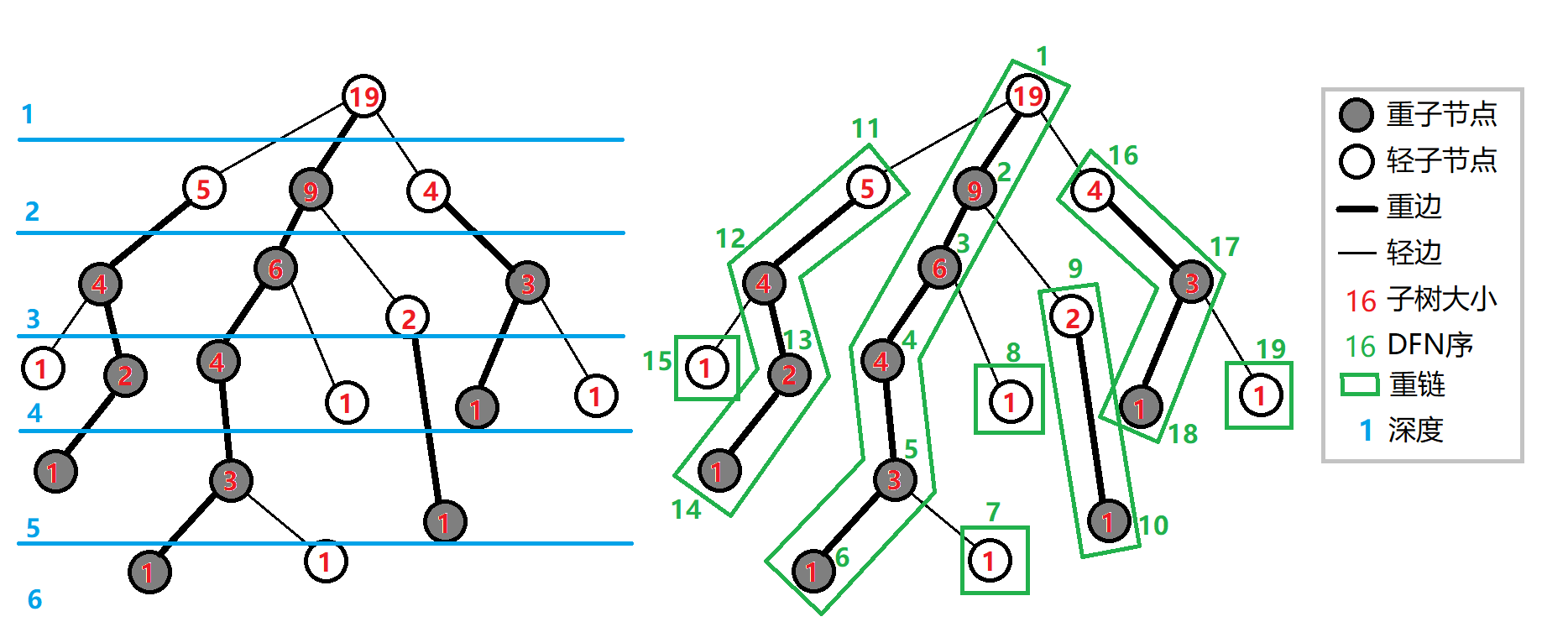
一些性质
1、当树的节点为\(n\)时,最多有\(n-1\)条重链(特殊的,当树只有1个节点时,只有1条重链)
2、树上每个节点都属于且仅属于一条重链
3、重链开头的节点只能是根节点或轻子节点
4、所有的重链将整棵树完全剖分
5、在剖分时,重边优先遍历,最后树的\(dfs\)序上,重链内的\(dfs\)序是连续的。按\(dfn\)排序后的序列即为剖分后的链。
6、一棵子树内的\(dfs\)序是连续的
7、当向下经过一条轻边时,所在子树的大小至少会除以2
8、对于树上的任意一条路径,都可以被拆分成不超过\(O(logn)\)条重链。
解释上面的性质:
1、每条重链的末尾都是叶子节点,而叶子节点又只能属于一条重链,因此重链的条数等于叶子的数量,当树为星型结构时,重链最多,为\(n-1\)条
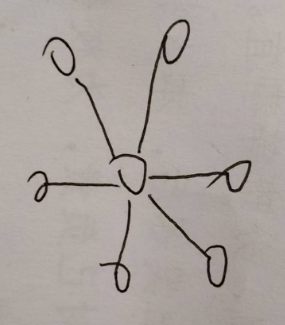
7、轻边\((u,v)\),\(size(v)<=size(u)/2\)
8、每增加一条重链,必定是通过轻边跳过去,所以重链的数量等于轻边的数量,而每经过一条轻边,点的数量至少会减少一半,所以最多经过\(logn\)条轻边,重链的数量最多也是\(logn\)。假如求\(x->y\)经过的重链条数,不用管\(lca\),直接\(x\)当成根节点思考就可以。
应用
1、求lca
2、拆分成链,用数据结构维护
具体实现
- \(fa(x)\)表示节点\(x\)在树上的父亲
- \(dep(x)\)表示节点\(x\)在树上的深度
- \(siz(x)\)表示节点\(x\)的子树的节点个数
- \(son(x)\)表示节点\(x\)的重儿子
- \(top(x)\)表示节点\(x\)所在重链的顶部节点(深度最小)
- \(dfn(x)\)表示节点\(x\)的\(dfs\)序,也是其在线段树中的编号
- \(rnk(x)\)表示\(dfs\)序所对应的节点编号,有\(rnk(dfn(x))=x\)
我们进行两遍\(dfs\)预处理出这些值
第一次\(dfs\)求出\(fa(x)\),\(dep(x)\),\(siz(x)\),\(son(x)\)
第二次\(dfs\)求出\(top(x)\),\(dfn(x)\),\(rnk(x)\)
例题
【模板】重链剖分/树链剖分
https://www.luogu.com.cn/problem/P3384
#include <bits/stdc++.h>
using namespace std;
#define lson (rt << 1)
#define rson (rt << 1 | 1)
const int maxn = 1e5 + 10, maxm = 1e5 + 10;
//r:根节点 p:模数
int n = 0, m = 0, r = 0, p = 0;
int a[maxn] = {};
//邻接链表变量
int h[maxn] = {}, nxt[maxm<<1] = {}, to[maxm<<1] = {}, tot = 0;
//重链剖分变量
//fa(x) 表示节点 x 在树上的父亲
//dep(x) 表示节点 x 在树上的深度
//siz(x) 表示节点 x 的子树的节点个数
//son(x) 表示节点 x 的 重儿子
//top(x) 表示节点 x 所在 重链 的顶部节点(深度最小)
//dfn(x) 表示节点 x 的 DFS 序,也是其在线段树中的编号
//rnk(x) 表示 DFS 序所对应的节点编号,有 rnk(dfn(x))=x
//cnt 用来求dfs序
int fa[maxn] = {}, dep[maxn] = {}, siz[maxn] = {}, son[maxn] = {}, top[maxn] = {};
int dfn[maxn] = {}, rnk[maxn] = {}, cnt = 0;
//线段树变量
struct node
{
int l, r, sum, lazy;
}tree[maxn<<2];
void pushup(int rt)
{
tree[rt].sum = (tree[lson].sum + tree[rson].sum) % p;
}
//把当前节点rt的延迟标记下放到左右儿子
void pushdown(int rt)
{
if(tree[rt].lazy)//此节点有延迟标记
{
int lz = tree[rt].lazy;
tree[rt].lazy = 0;//记住要清零
tree[lson].lazy = (tree[lson].lazy + lz) % p;
tree[rson].lazy = (tree[rson].lazy + lz) % p;
tree[lson].sum = (tree[lson].sum + lz * (tree[lson].r - tree[lson].l + 1) % p) % p;
tree[rson].sum = (tree[rson].sum + lz * (tree[rson].r - tree[rson].l + 1) % p) % p;
}
}
//建树
//l和r对应的是dfn
void Build(int rt, int l, int r)
{
tree[rt].l = l;
tree[rt].r = r;//节点信息初始化
if(l == r)//到叶节点
{
//l为dfn值,所以rnk[l]对应的是原来的点
tree[rt].sum = a[rnk[l]] % p;
return;
}
int mid = (l + r) >> 1;
Build(lson, l, mid);
Build(rson, mid+1, r);
pushup(rt);//子树建好后,回溯时更新父节点信息
}
void Update(int rt, int l, int r, int val)
{
//更新区间完全覆盖节点表示的区间
if(l<=tree[rt].l && tree[rt].r<=r)
{
tree[rt].lazy = (tree[rt].lazy + val) % p;
tree[rt].sum = (tree[rt].sum + val * (tree[rt].r - tree[rt].l + 1) % p) % p;
return;
}
//如果不能完全覆盖,此时需要向下递归,要下放标记
pushdown(rt);
int mid = (tree[rt].l + tree[rt].r) >> 1;
if(l <= mid) Update(lson, l, r, val);
if(r > mid) Update(rson, l, r, val);
pushup(rt);
}
//当前节点为rt,要查询的区间是[l, r]
int Query(int rt, int l, int r)
{
int ret = 0;
//如果节点表示的区间是查询区间的真子集
if(l<=tree[rt].l && tree[rt].r<=r)
{
return tree[rt].sum % p;
}
//如果不能完全覆盖,此时需要向下递归,要下放标记
pushdown(rt);
int mid = (tree[rt].l + tree[rt].r) >> 1;
if(l <= mid) ret = (ret + Query(lson, l, r)) % p;
if(r > mid) ret = (ret + Query(rson, l, r)) % p;
return ret;
}
void addedge(int x, int y)
{
to[++tot] = y;
nxt[tot] = h[x];
h[x] = tot;
}
//求出 fa(x),dep(x),siz(x),son(x)
void dfs1(int x)
{
son[x] = -1;
siz[x] = 1;
for(int i=h[x]; i; i=nxt[i])
{
int y = to[i];
if(!dep[y])
{
dep[y] = dep[x] + 1;
fa[y] = x;
dfs1(y);
siz[x] += siz[y];
if(son[x]==-1 || siz[y]>siz[son[x]]) son[x] = y;
}
}
}
//求出 top(x),dfn(x),rnk(x)
void dfs2(int x, int t)
{
top[x] = t;
cnt++;
dfn[x] = cnt;
rnk[cnt] = x;
if(son[x] == -1) return; //x为叶子节点
dfs2(son[x], t);// 优先对重儿子进行 DFS,可以保证同一条重链上的点 DFS 序连续
for(int i=h[x]; i; i=nxt[i])
{
int y = to[i];
//y为轻儿子时,单独开一条链,y为链顶端点
if(y!=son[x] && y!=fa[x]) dfs2(y, y);
}
}
void add1(int x, int y, int val)
{
//跳重链
while(top[x] != top[y])
{
if(dep[top[x]] < dep[top[y]]) swap(x, y);
Update(1, dfn[top[x]], dfn[x], val);
x = fa[top[x]];
}
//已跳到同一条重链
if(dep[x] > dep[y]) swap(x, y);
Update(1, dfn[x], dfn[y], val);
}
int query1(int x, int y)
{
int ret = 0;
//跳重链
while(top[x] != top[y])
{
if(dep[top[x]] < dep[top[y]]) swap(x, y);
ret = (ret + Query(1, dfn[top[x]], dfn[x])) % p;
x = fa[top[x]];
}
//已跳到同一条重链
if(dep[x] > dep[y]) swap(x, y);
ret = (ret + Query(1, dfn[x], dfn[y])) % p;
return ret;
}
int main()
{
int op = 0, x = 0, y = 0, z = 0;
scanf("%d%d%d%d", &n, &m, &r, &p);
for(int i=1; i<=n; i++) scanf("%d", &a[i]);
for(int i=1; i<n; i++)
{
scanf("%d%d", &x, &y);
addedge(x, y);
addedge(y, x);
}
//执行重链剖分,两遍 DFS 预处理出这些值,
//第一次 DFS 求出 fa(x),dep(x),siz(x),son(x)
dep[r] = 1;
dfs1(r);
//第二次 DFS 求出 top(x),dfn(x),rnk(x)。
dfs2(r, r);
//针对dfn序建树
Build(1, 1, cnt);
while(m--)
{
scanf("%d", &op);
if(op == 1)
{
scanf("%d%d%d", &x, &y, &z);
add1(x, y, z);
}
else if(op == 2)
{
scanf("%d%d", &x, &y);
int ans = query1(x, y);
printf("%d\n", ans);
}
else if(op == 3)
{
scanf("%d%d", &x, &z);
Update(1, dfn[x], dfn[x]+siz[x]-1, z);
}
else if(op == 4)
{
scanf("%d", &x);
int ans = Query(1, dfn[x], dfn[x]+siz[x]-1);
printf("%d\n", ans);
}
}
return 0;
}




 浙公网安备 33010602011771号
浙公网安备 33010602011771号